My Great Lakes Cruise Review
Update August 2024 — QC’s Anne Kalosh reports, “Good news for Great Lakes cruisers, there will soon be another choice with the rebirth of Victory Cruise Lines in 2025. Its former owner, John Waggoner, picked up the coastal vessels Victory I and Victory II at the bankruptcy auction for American Queen Voyages, a company he founded and ran until a few years ago. Read more HERE.
My wife, Laurel, and I have made many dozens of deep-water cruises throughout much of the world, but our own Great Lakes, though high on our wish list, had eluded us.
Too pricey, we felt, and we still thought that earlier this summer about Ocean Voyager’s and sister Ocean Navigator’s 9-night Toronto-Chicago cruises (10 nights with the included pre-cruise hotel stay), also operated in reverse.
The rack rate minimum was $4,999 per person, also the listed price of sailings from now into the early fall (a few longer voyages reaching Montreal are more).
These ships, registered in the Bahamas, had been the Victory I and Victory II until the September 2021 rebranding that brought Victory Cruise Lines and American Queen Steamboat Company under the umbrella of American Queen Voyages. (UPDATE: American Queen Voyages shuts down and ships are sold off.)
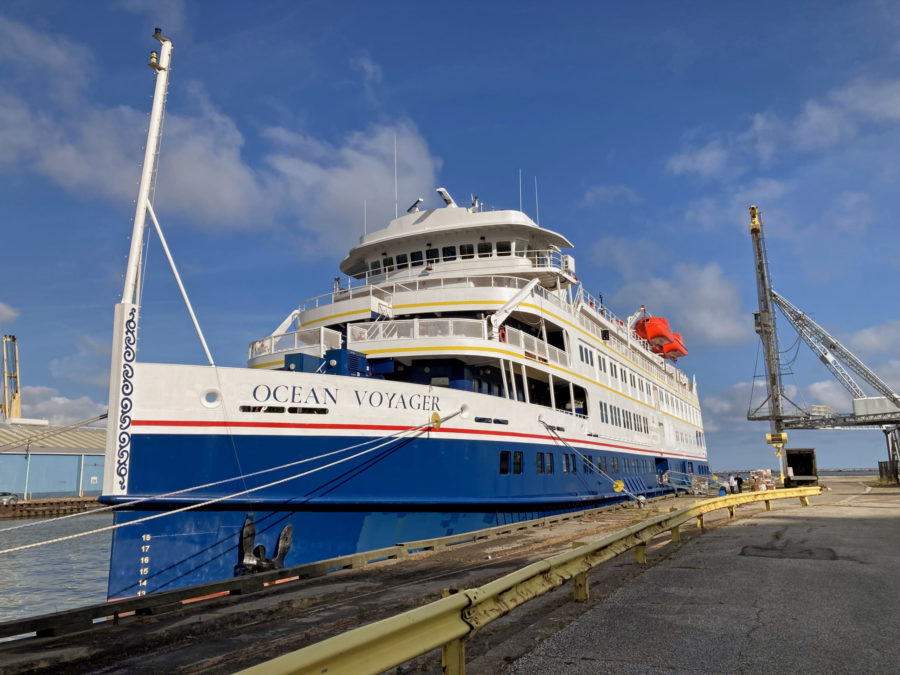
In Cleveland, the 202-pax Ocean Voyager poses proudly in the morning sun. * Photo: Karl Zimmermann
Subscribe to our monthly small-ship cruise email
Subscribe to QuirkyCruise.com for monthly curated newsletters highlighting our top small cruise ship reviews, round-ups & offers!
A Small Ship Cruise on the Ocean Voyager — a Good Buy
However, eagle-eyed Laurel spotted two Toronto-based cruises that were half that price, and we jumped on one, a July 5 departure on the Ocean Voyager.
The only available cabins were a category higher, slightly more expensive, and government taxes were a whopping $509 apiece, apparently because the itinerary bounced between Canadian and American ports.
We were responsible for tipping, but most drinks, alcoholic and otherwise, were included, as were internet and a shore excursion at each port.
The two sister ships began life in 2001 as the Cape May Light (our ship) and 2004 as the Cape Cod Light, and had been on our radar screen since then.
With a passenger capacity today of 202 (there were 176 on our sailing), all in double outside cabins (there are some inside cabins, now used for staff), the ship’s size—small (285-feet long)—and configuration—lots of deck space—were appealing to us.
RELATED: Judi Cohen reviews her Great Lakes cruise aboard Viking Octantis.
RELATED: Ted Scull tells us lots about cruising the Great Lakes.
Toronto Plus & Minus
Our included pre-cruise hotel was the Hilton Toronto—comfortable, well-located downtown, near the Rogers Centre, with an attractive indoor-outdoor pool. We could see the CN Tower out our window, but a foggy overcast ruled out going up.
(Toronto is one of North America’s great cities, well worth additional days before or after sailing. The same could be said of Chicago on the small-ship cruises beginning there.)
Opening off the lobby was the expansive Tundra Restaurant, very workable for those of us a bit travel-weary and not eager to explore. It features a large U-shaped bar, to which a number of us fled immediately after an onerous check-in.
Much of the blame for that could be laid on ArriveCAN, the jauntily named app that was not our friend. We’d had to complete it before United would issue us boarding passes to fly from Newark to Toronto Pearson.
Then at the poorly organized multiple-hurdle embarkation check-in at the hotel the day before sailing (by far the worst we’ve ever experienced) that included a COVID test, there was another ArriveCAN application (fortunately there was a young techie on hand to help) and the check-in itself.
When we finished we exited past a queue of at least two dozen not-pleased passengers waiting their turn.
Then there was an early bag-pull at 8 a.m. the next morning, and finally our bus transfer to the ship at 3 p.m.
The fact that the boat would toggle between Canadian and American ports would mean multiple immigration checks.
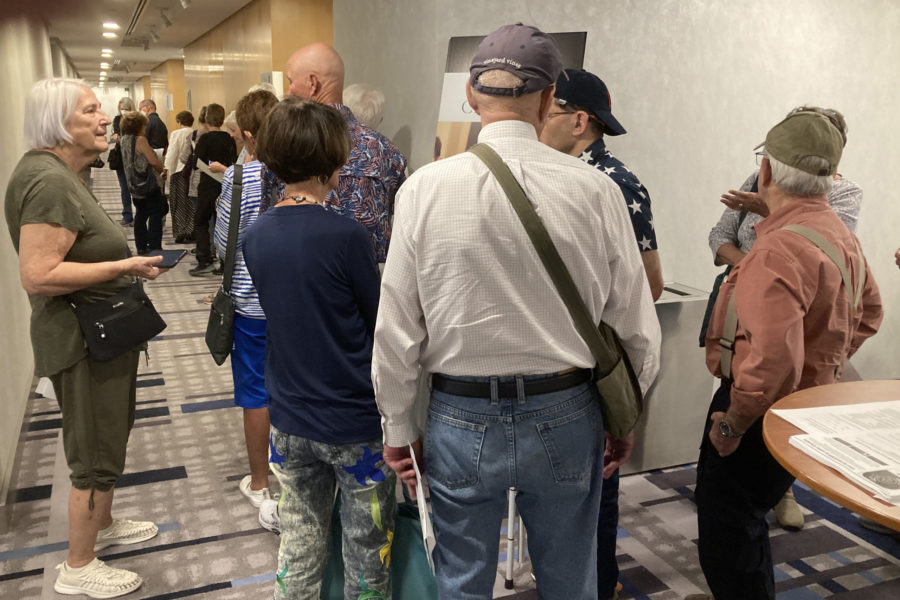
A bad start at the Hilton Toronto as the check-in line moved slowly. * Photo: Karl Zimmermann
Glad to be Aboard Ocean Voyager — My Great Lakes Cruise Review
When we arrived at the boat our spirits lifted.
In the Compass Lounge, the small ship’s social center, we breezed through on-board check-in and went to our cabin, where our luggage awaited.
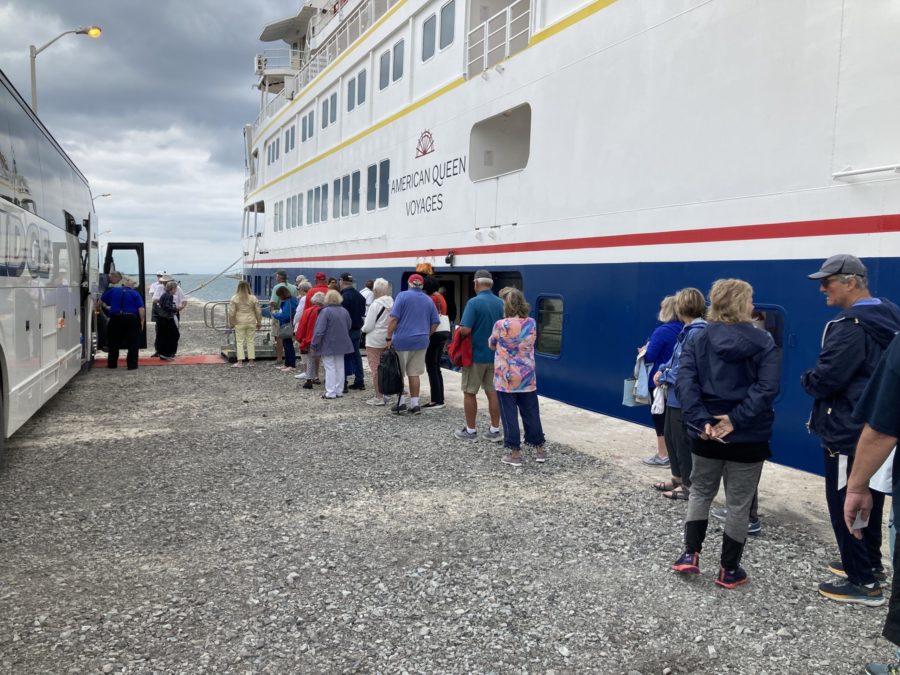
When we reached the vessel for boarding, things looked up. * Photo: Karl Zimmermann
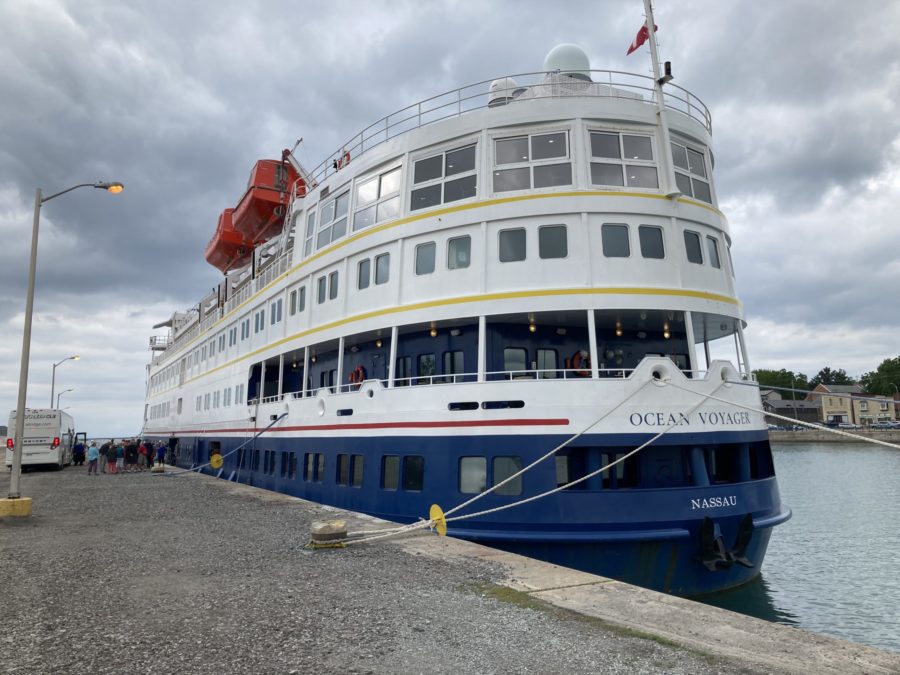
With boarding concluding, I checked out the stern. The Deck 4 windows are the Grill and the Deck 1 the Coastal Dining Room. * Photo: Karl Zimmermann
Other than two Owner’s Suites, which command a substantial private deck, the staterooms are all similarly sized, around 150 square feet, and similarly equipped: queen bed in ours (virtually all rooms can be configured with twins), ample closet and shelf space, a small desk and chair.
We’d been upgraded to a category B on Deck 3.
As is typically the case shipboard, category and price ascend with the deck; higher deck means higher price.
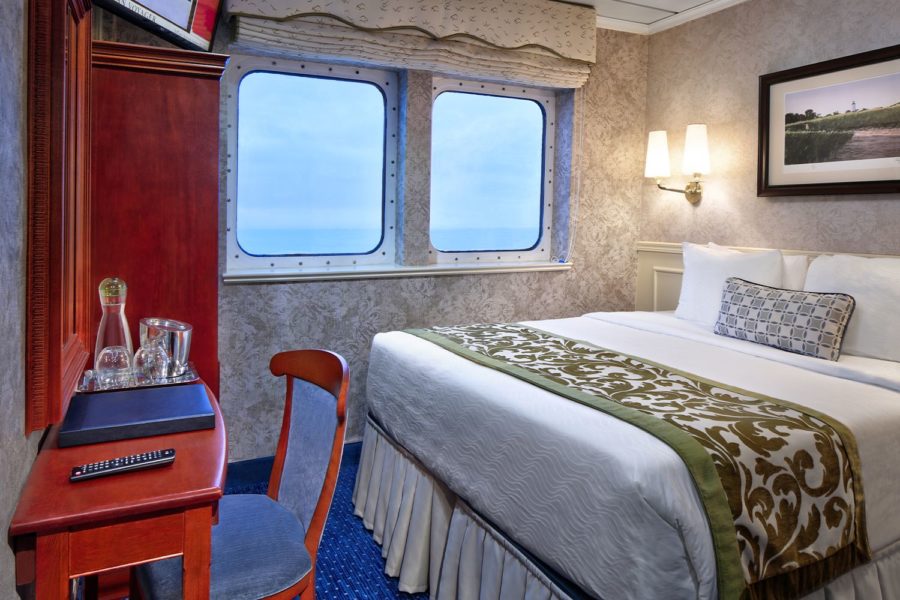
Ocean Voyager’s B-category cabin. * Photo: American Queen Voyages
Ocean Voyager is a Tidy Little Vessel
A highlight when I board a ship new to me is exploration, and that was the next order of business, even before unpacking.
As a traditionalist, I was pleased that there was a “Purser’s Office” instead of “Guest Services” or whatever, and that the decks were numbered rather than dubbed with hokey names.
There were names secondarily, but descriptive and time-honored: Observation, Cabin, Saloon, and Main.
I started one deck up from our cabin, on Observation, where I found (aside from the Owner’s suites) the choicest accommodations, larger by inches but, much more importantly, opening right onto the deck in classic steamship fashion.
In fact, the Ocean Voyager and Ocean Navigator have a retro look suggesting the century-old design typical of coastal overnight boats, with dining room, saloon, and decks for fresh air, all suitable for one-night journeys.

Observation deck, Deck 4, was my favorite spot. The captain’s cabin was the choicest. * Photo: Karl Zimmermann
Decked — Drawn to Ocean Voyager’s Deck 4
This deck is where I spent my happiest moments on the cruise.
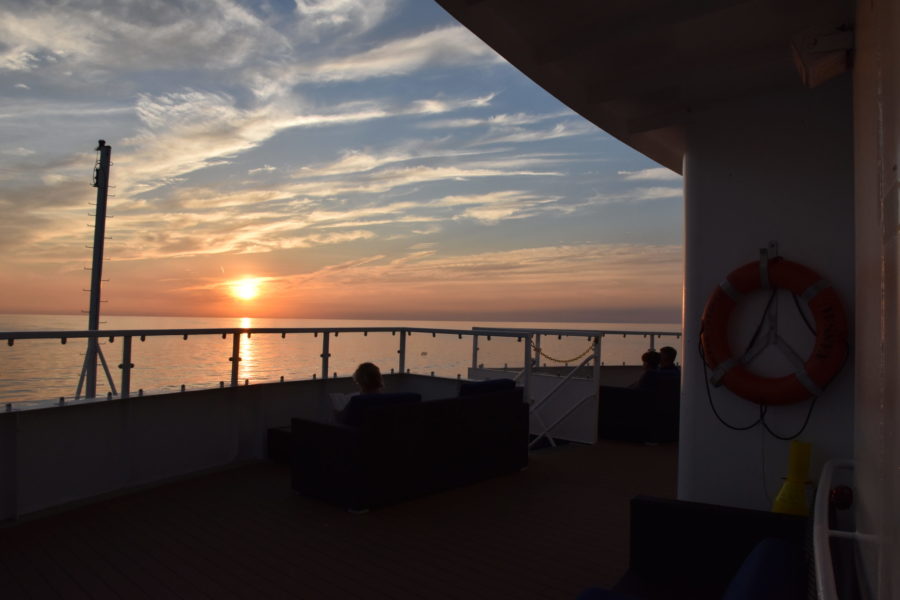
The Terrace, forward on Deck 4, was the lookout, a favorite spot of those passengers who favored deck time. * Photo: Karl Zimmermann
Forward was a large space dubbed the Terrace with four sofas. And the side decks were lined with chairs, which seemed to align with the cabins.
Having been burned by Holland America Line’s ill-advised “Lanai Suites” that similarly opened directly to the deck, each claiming proprietary use of a pair of deck chairs, I worried.
I needn’t have, as these were open to all, and eventually we sat in many of them.
We tag-teamed at Sault Ste. Marie and shared a wharf on Mackinac Island with Pearl Mist, Pearl Seas Cruises’ only vessel which featured private verandahs.
I preferred our arrangement for the flexibility and congeniality it offered, but as things turned out a verandah wouldn’t have been a bad thing.

The Pearl Mist, docked across from us at Mackinac Island, sails ahead of us. By this point we’ve changed our tune and would have welcomed a veranda. * Photo: Karl Zimmermann
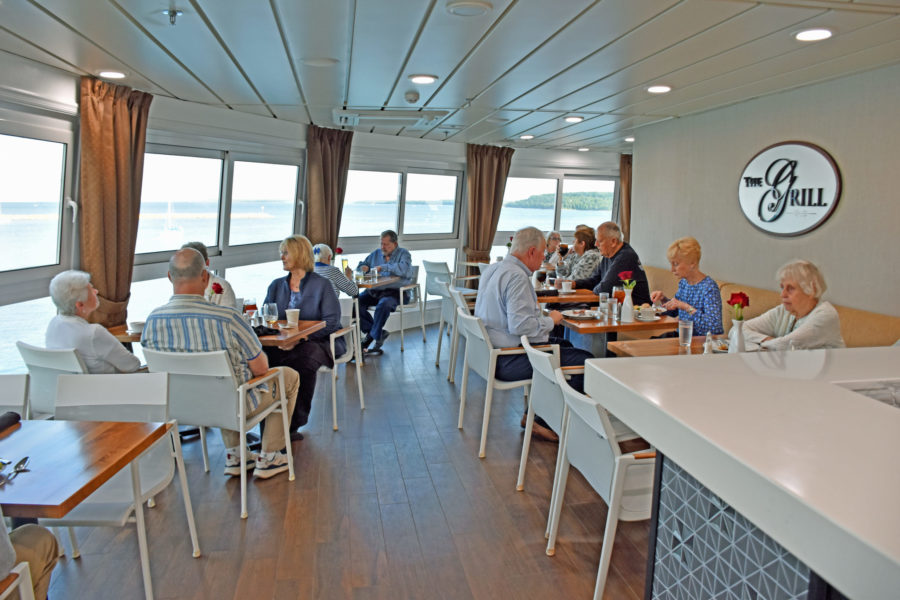
The Grill was an informal spot for a buffet meal. The carved roast beef was a staple, and I succumbed more than once. * Photo: Karl Zimmermann
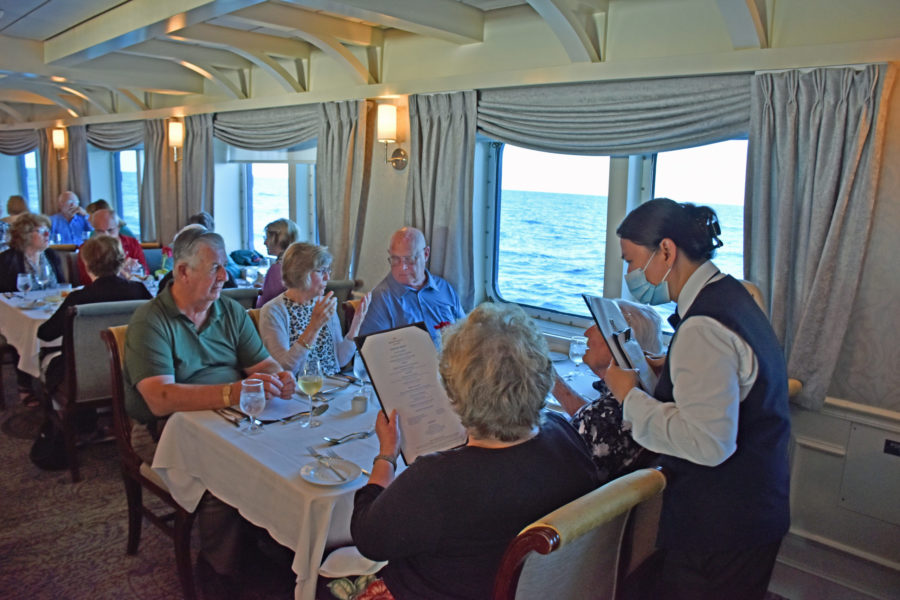
The Coastal dining Room was also bright and attractive, and the service gracious and attentive. * Photo: Karl Zimmermann
Aft was The Grill, a bright and cheerful spot that most nights offered a buffet dinner featuring many of the items from the main Coastal Dining Room, and sometimes breakfast and lunch too. (In either place we found the meals consistently delicious and well-presented.)
From Deck 4 stairs led up to two sections of Sun Deck. The one aft seemed promising, with sofas and cocktail tables under a canopy, flanked by tables and chairs, with a few chaise longue-style deck chairs. However, the constant ventilator noise kept us from settling there. (Full disclosure: engine vibration and noise are an issue in the Coastal Dining Room, low and aft, when the vessel is underway.)

The Sun Deck aft seemed to have promise but the noise was a deterrent. Out of this picture to the right was a canopied lounging area. * Photo: Karl Zimmermann
Drinks on the House, Mostly
I ended my tour in the Tavern, forward of the Compass Lounge on Saloon Deck, where Laurel joined me for a martini as god intended—gin, a splash of vermouth, and olives. Premium or “call” brands had an up-charge but “well drinks,” made with standard brands, were fine with us.
This room is woody and cozy, living up to its name as the ship’s watering hole. Drinks from there were also served in the Compass Lounge, the happenin’ place.
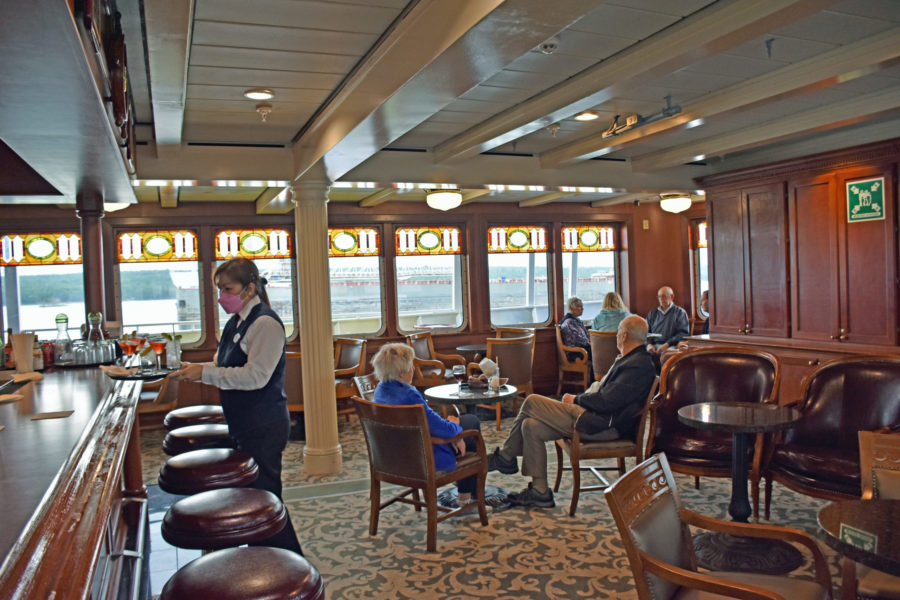
The Tavern was a classic watering hole. * Photo: Karl Zimmermann
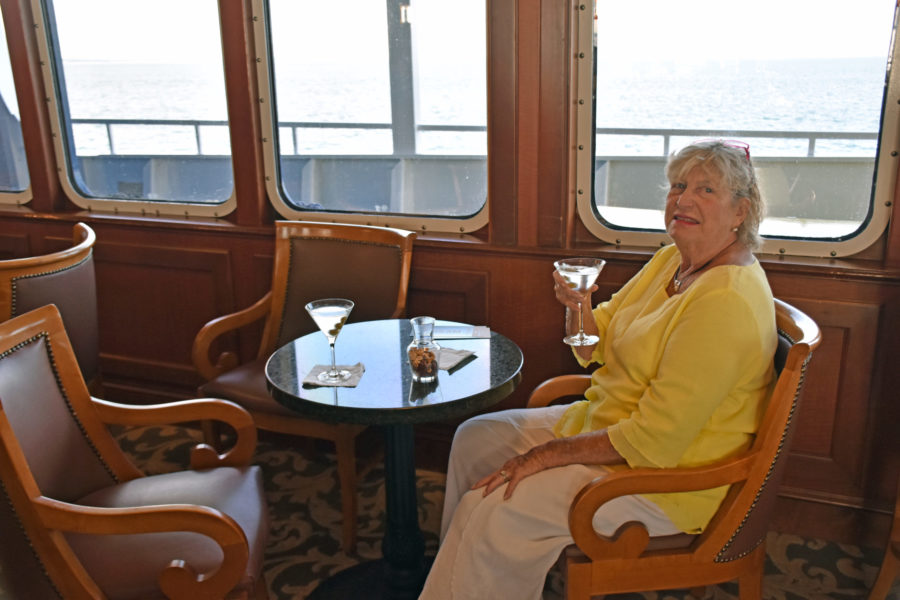
Laurel and I tried it out early for martinis. * Photo: Karl Zimmermann
Never a Dull Moment
Here on the second night, Captain Voytec Ziolkowski introduced the officers at his welcome reception.
The shortest among them, on his far right in the line, was the ship’s doctor, and he made the obligatory joke about hoping none of us would get to know him. Unfortunately, Laurel and I eventually did.
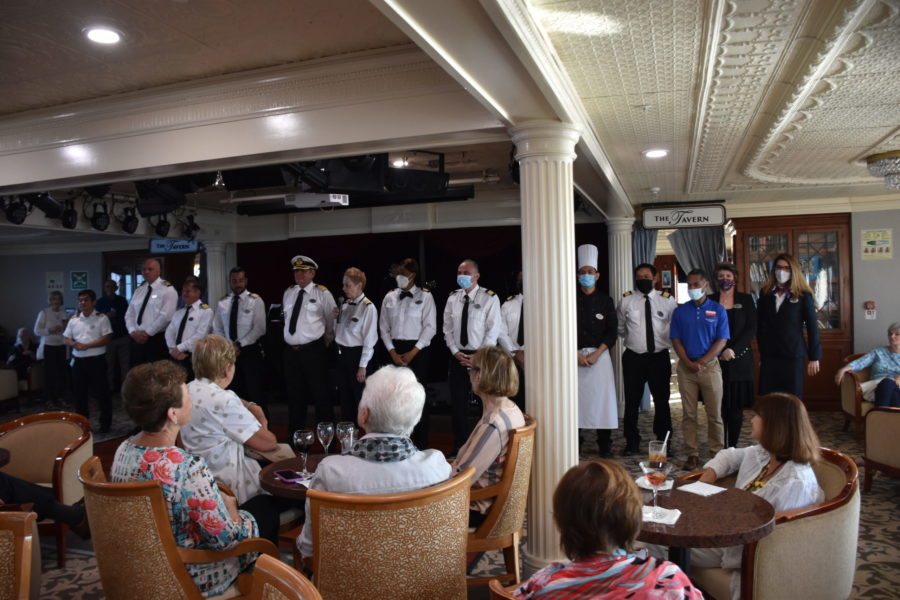
The full array of officers as introduced by the captain at his reception in the Compass Lounge. * Photo: Karl Zimmermann
The Compass Lounge was home base for Ian Ross, the peripatetic cruise director who wore many hats, all engagingly and excellently.
He offered a two-part lecture, “People of the Inland Sea,” and also “Ecology of the Great Lakes,” highlighting both successes and failures in keeping the lakes healthy.
Even more important, as guitarist Ross led an excellent and versatile combo backed by Sean on piano and Andre on drums at cocktails nightly. Each evening after dinner was a show: classic country, Motown, crooners, piano man.
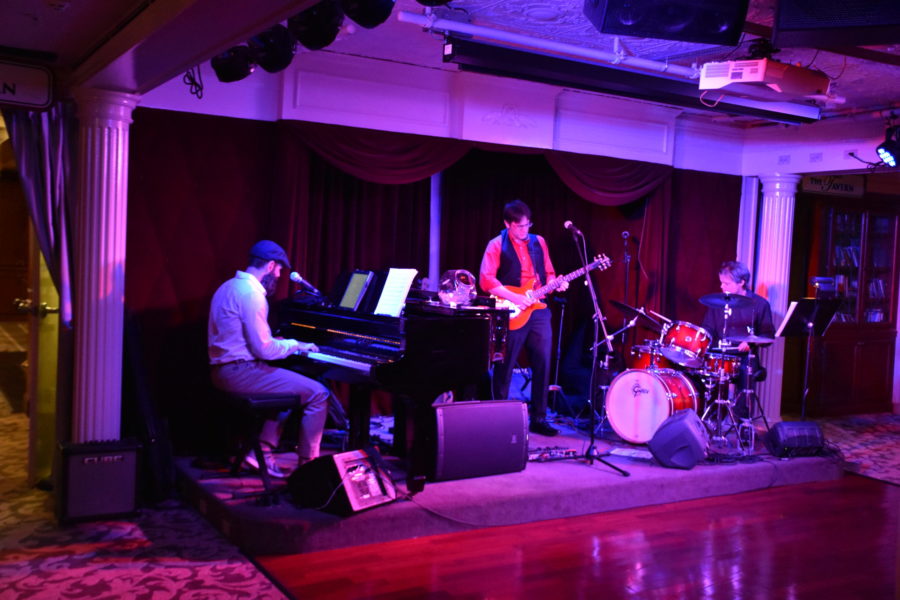
Sean, Ian, and Andre were splendid as the Ocean Voyager Band. * Photo: Karl Zimmermann
Most afternoons offered a matinee movie, sometimes thematically linked to a port of call. Later came daily trivia, and one day bingo, especially well attended.
On the final “sea day” into Chicago there was an elegant white-glove tea service.
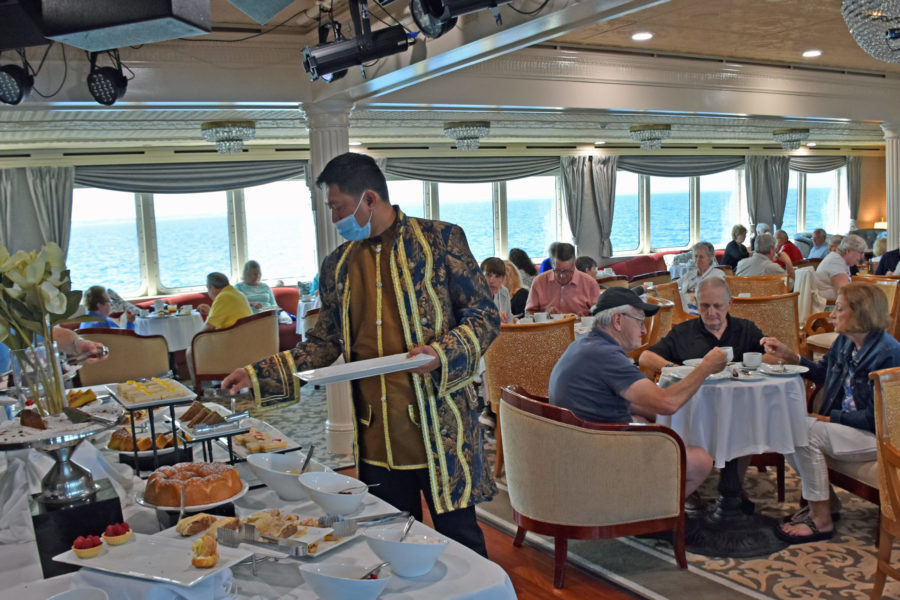
On the last afternoon aboard as we headed south down Lake Michigan, the Compass Lounge hosted a formal tea. * Photo: Karl Zimmermann
Much of this got short shrift from me, however, partly because of enforced absence (more about that later), but also because my heart belonged to the decks.
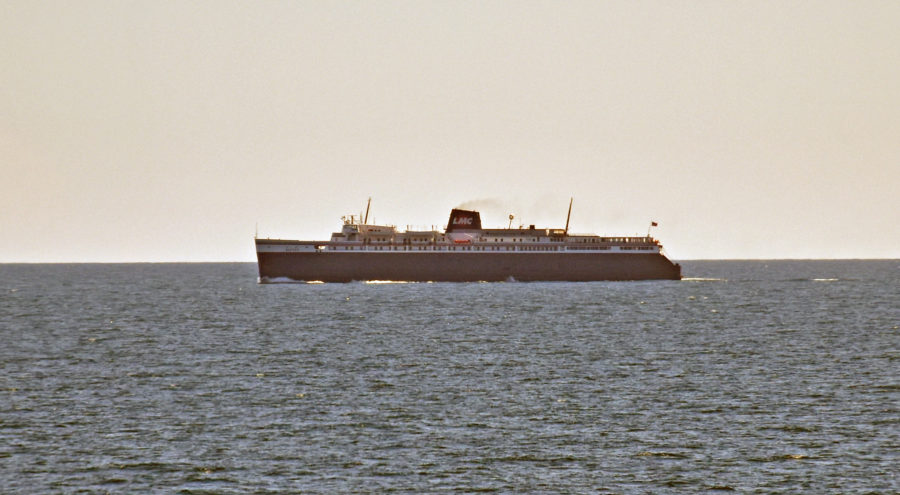
During the tea, I snuck out on deck and serendipity rewarded me with a view of the S.S Badger, a favorite of mine, a former railroad car ferry (it now carries trucks and automobiles), still coal-burning, built in 1953. It was plying from Manitowoc, Wis., to Ludington, Mich. * Photo: Karl Zimmermann
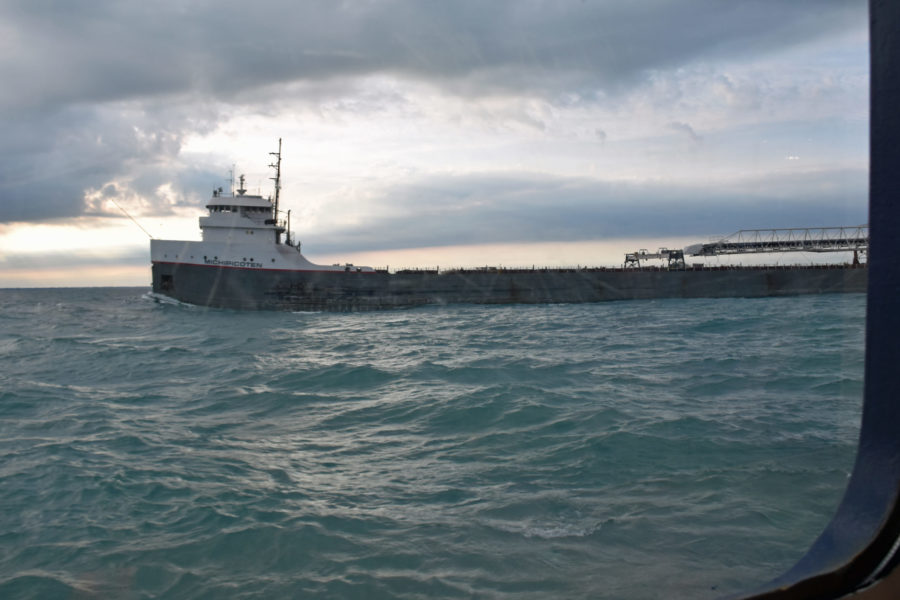
Whether on deck or inside, I had an eye peeled for lake traffic. This view through the window is of the 1952-built Michipicoten down-bound on choppy Lake Erie. * Photo: Karl Zimmermann
Tours, Tours, Tours on a Great Lakes Cruise
Also in the Compass Lounge, personable, vivacious Wendy Strickler, the shore excursions manager, would introduce the ports and the tours available. (An excellent map specific to our visits was provided for each port.)
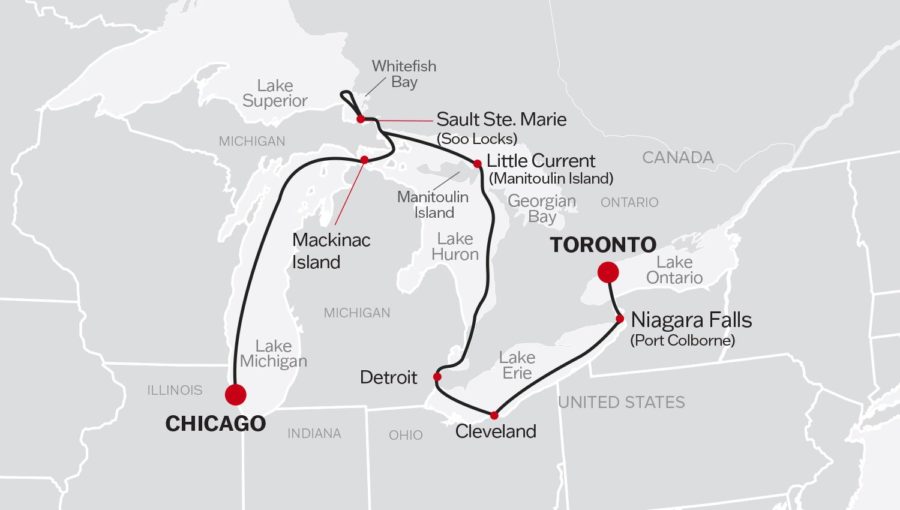
A map of the 9-night route. * Map: American Queen Voyages
From Toronto our cruise would cross Lake Ontario to the Welland Canal, where eight locks would lift us 326 feet up the Niagara Escarpment that creates the famous falls.
We’d awake the next morning at Port Colborne, the canal’s south end.
From there the Niagara Falls tours would depart, and after getting back on board we’d cross Lake Erie to Cleveland and then on to Detroit.
The following day was spent steaming north on Lake Huron to Little Current on Manitoulin Island, and from there on to Sault Ste. Marie, then Mackinac Island before a north-south transit of Lake Michigan to Chicago.
We’d have smooth sailing all the way, including on Lake Erie. By far the shallowest of the Great Lakes, that makes it most prone to choppiness, which we skimmed over undaunted.
“How many of you made this cruise especially to see Niagara Falls?” Wendy asked the first night in introducing those tours, and lots of hands went up.
“How many of you made this cruise especially to see Cleveland?” she asked the next night, and was greeted by laughter rather than raised hands, though she countered that Cleveland had plenty to offer, and I would agree.
The passenger list, we thought, mostly comprised sophisticated cruisers who chose the Great Lakes as a new experience.
Traditional Cruise Documents by Snail Mail
We had gotten a tours preview before sailing when a thick, handsome packet, “Cruise Documents,” arrived by “snail mail,” containing honest-to-god luggage tags, general information, and a listing with thorough details of the excursions.
This paper rather than digital presentation was a throwback, and we liked it. Perhaps Victory Cruise Lines figured this would please a demographic that trended older, at least on our cruise.
The pattern for shore excursions throughout the voyage was an included tour, which we always found more than adequate, plus, in most cases, an up-sell alternative, typically longer and with extra features.
At Port Colborne, the starting point for Niagara Falls tours, we were happy with an afternoon half-day Falls trip that put us aboard a Hornblower’s Niagara City Cruise boat, owned by American Queen Cruises’ parent company.
It sailed from the Canadian side with the more famous Maid of the Mist boats now on the American side.
As an example, the “Premium Experience” for $149 at Niagara Falls added a ride up the Skylon Tower and wine-tasting at nearby Niagara-on-the-Lake.
“Premium” tours could be booked in advance, while tickets for included tours were available the evening before.
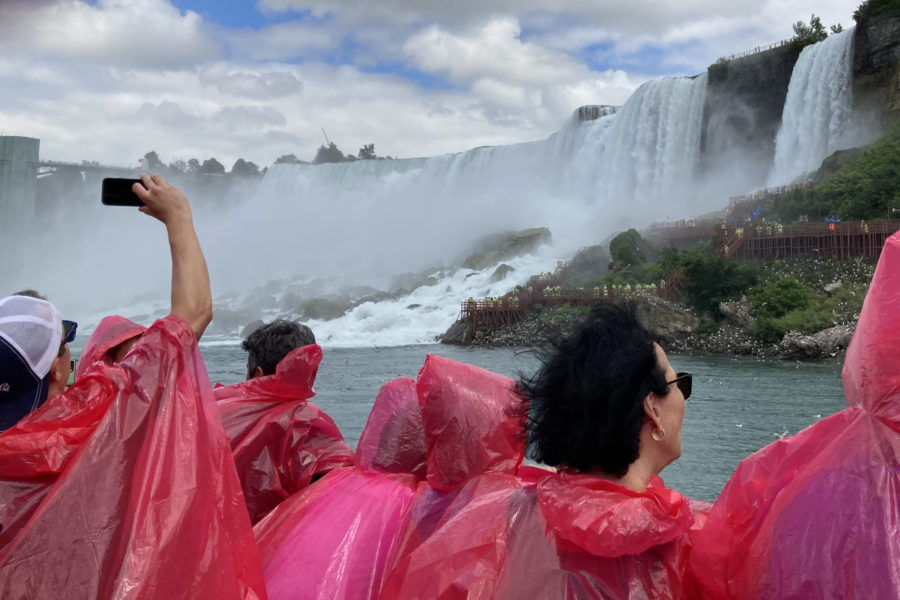
Getting wet is half the fun on our Niagara City Cruise boat that flirted with both the American and Canadian Falls. * Photo: Karl Zimmermann
Since Port Colborne marks the Lake Erie end of the Welland Canal, we had happily spent the morning on deck looking across at the small town and watching the canal traffic.
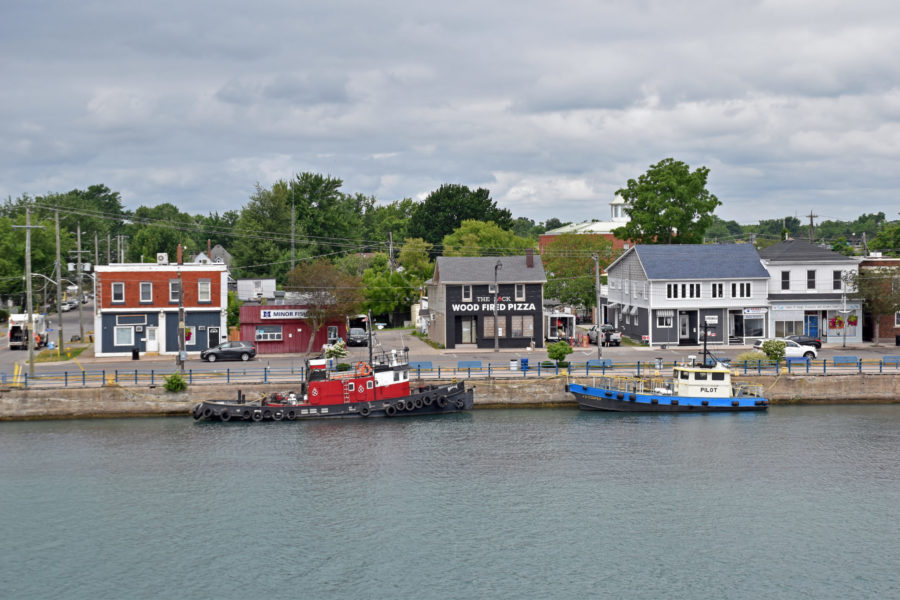
From our chairs on Deck 4 we watched the comings and goings in the little village of Port Colborne. * Photo: Karl Zimmermann
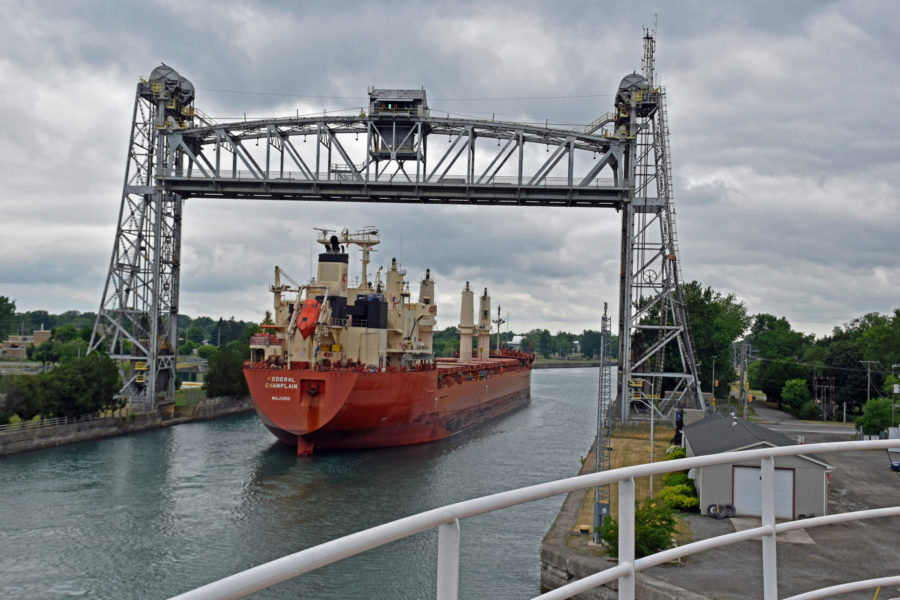
When the lift bridge at Port Colborne that led into the Welland Canal went up, we knew that a boat was near. This was the “saltie” Federal Champlain from Majuro. * Photo: Karl Zimmermann
Ports of Cleveland & Detroit Deliver
Cleveland was one of three ports offering hop-on, hop-off busses (on Mackinac Island there was a carriage tour, of course, since no motorized vehicles).
In Cleveland, we hopped off at the Rock & Roll Hall of Fame—a stunning I. M. Pei design, housing everything rock, including a simulated rock concert and a chance for museum-goers to try their hand with various instruments—and the excellent Cleveland Museum of Art, housing extensive and varied collections (with limited time, I hung out with the Impressionists).
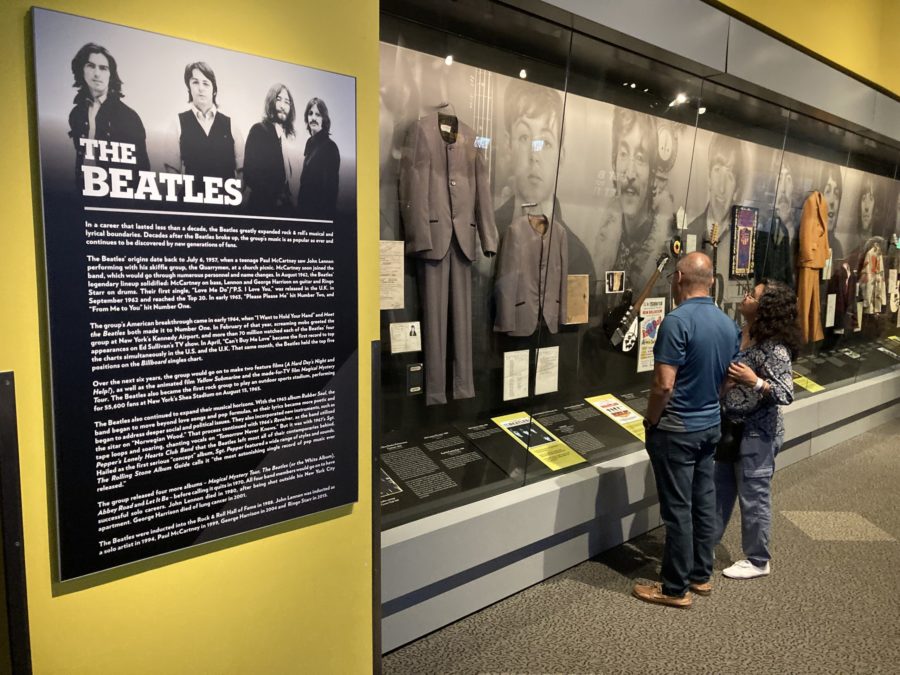
The Rock & Roll Museum could support an all-day visit. There was a special Beatles exhibit in addition to this one. * Photo: Karl Zimmermann

The Cleveland Museum of Art, among North America’s finest, blends the old and the new to house its many galleries. * Photo: Karl Zimmermann
The included city tour of Detroit took us to the Charles Wright Museum of African American History.
We were meant to go to the Canfield Street shopping area, but rain rerouted us to the magnificently Art Deco lobby of the 1928 Fisher Building—more than fine by me.
But trouble for the Zimmermanns was not far away.
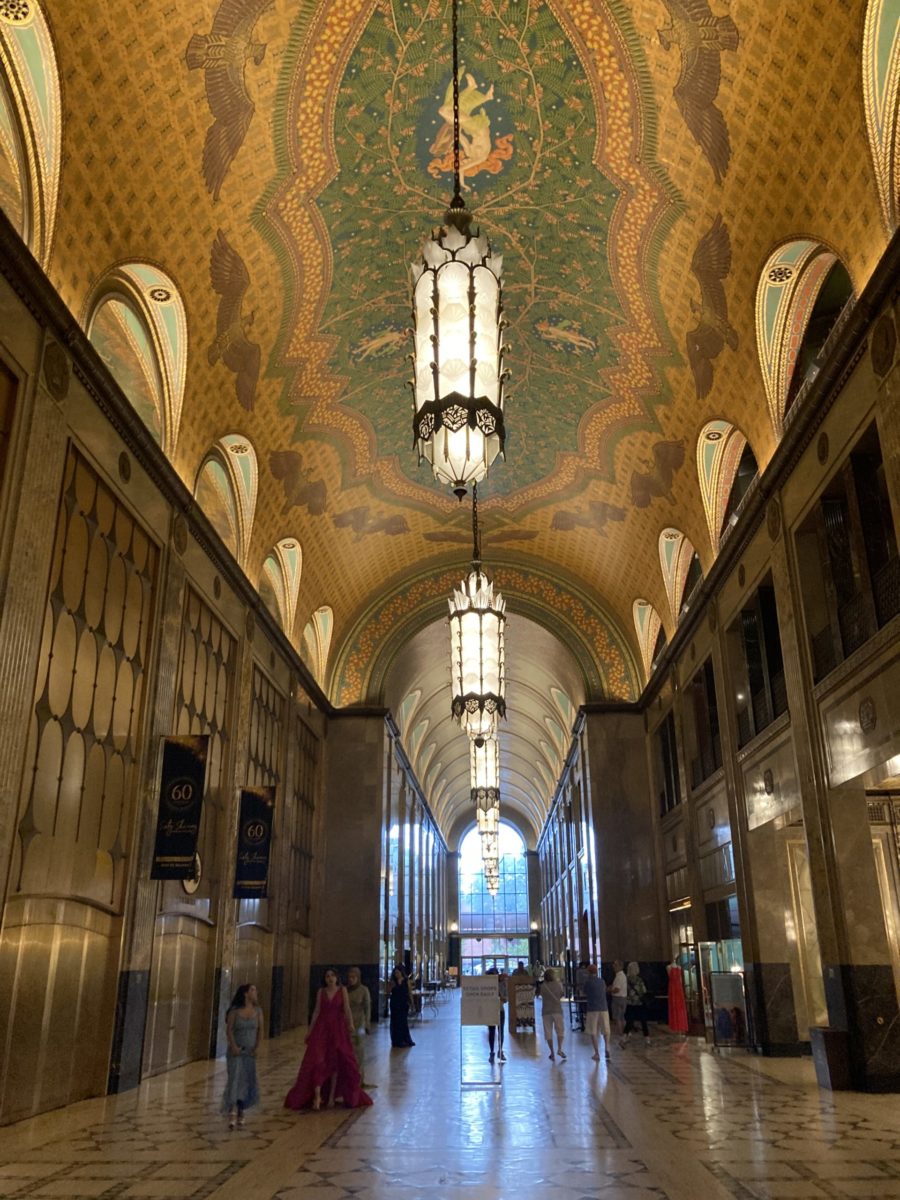
The lobby of the Fisher Building was a trip highlight for me. * Photo: Karl Zimmermann
And then Some Bad News
During a lovely sunset transit of the St. Clair River into Lake Huron, Laurel began to feel fluish.
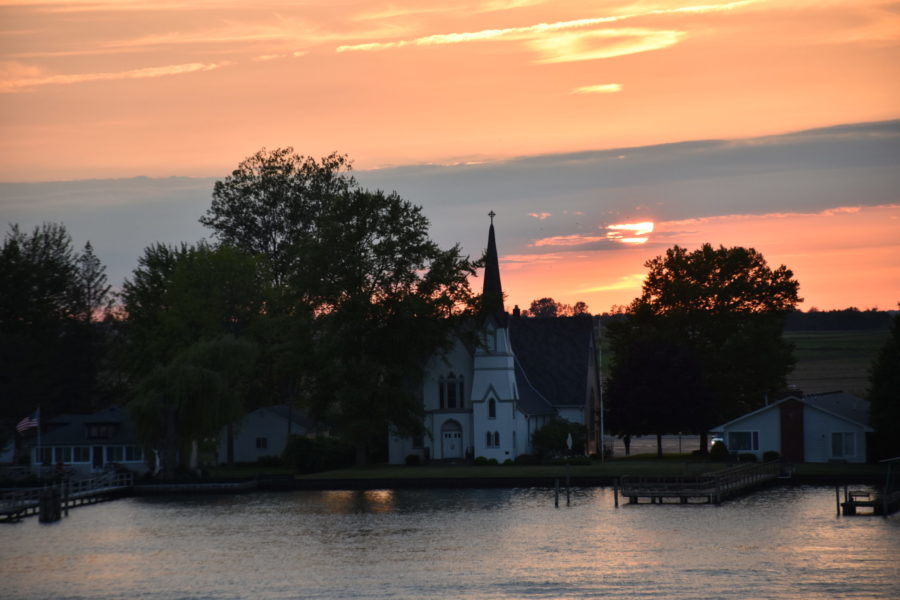
The sunset glows behind the American shore of the St. Clair River as we head to Lake Huron. * Photo: Karl Zimmermann

The American Courage down-bound in the St. Clair River sends us to our cabin and an uneasy sleep for Laurel. * Photo: Karl Zimmermann
The next morning a self-test, followed by one by the ship’s doctor, confirmed the worst: she had COVID, and our small but cozy cabin would become her quarantine cell for the balance of the voyage, and mine too at first. (We felt sure that this was not contracted shipboard. Circumstance and timing pointed to the Rock & Roll Hall of Fame.)
Little Current on Manitoulin Island, Sault Ste. Marie, Mackinac Island, and Lake Michigan for Laurel became what she could see from our two broad windows.

Quarantined in our cabin, we saw only this of Little Current on Manitoulin Island. Turners department store has been doing business for 125 years and now includes a museum, which of course we couldn’t visit. * Photo: Karl Zimmermann
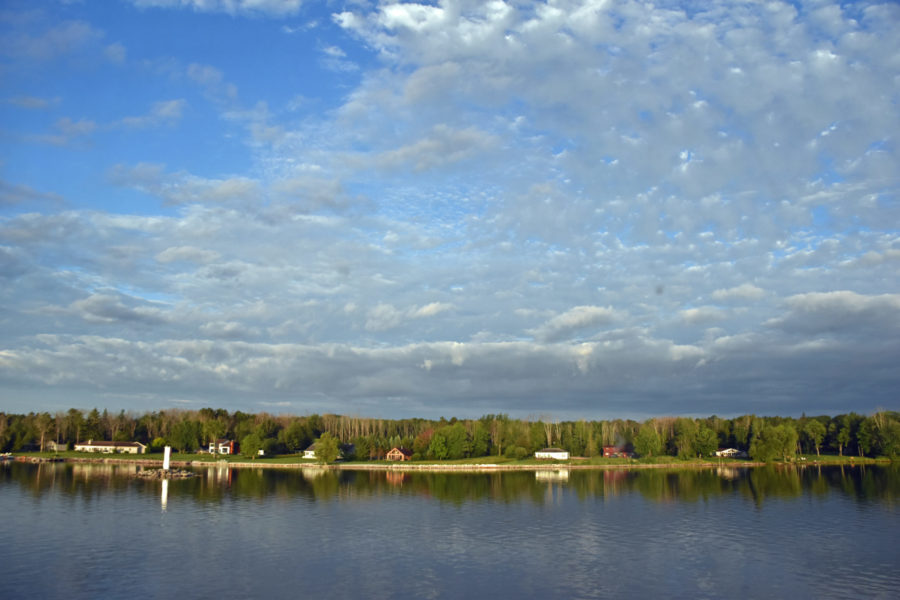
Through our window we saw this beautiful sky headed into Sault Ste. Marie. * Photo: Karl Zimmermann
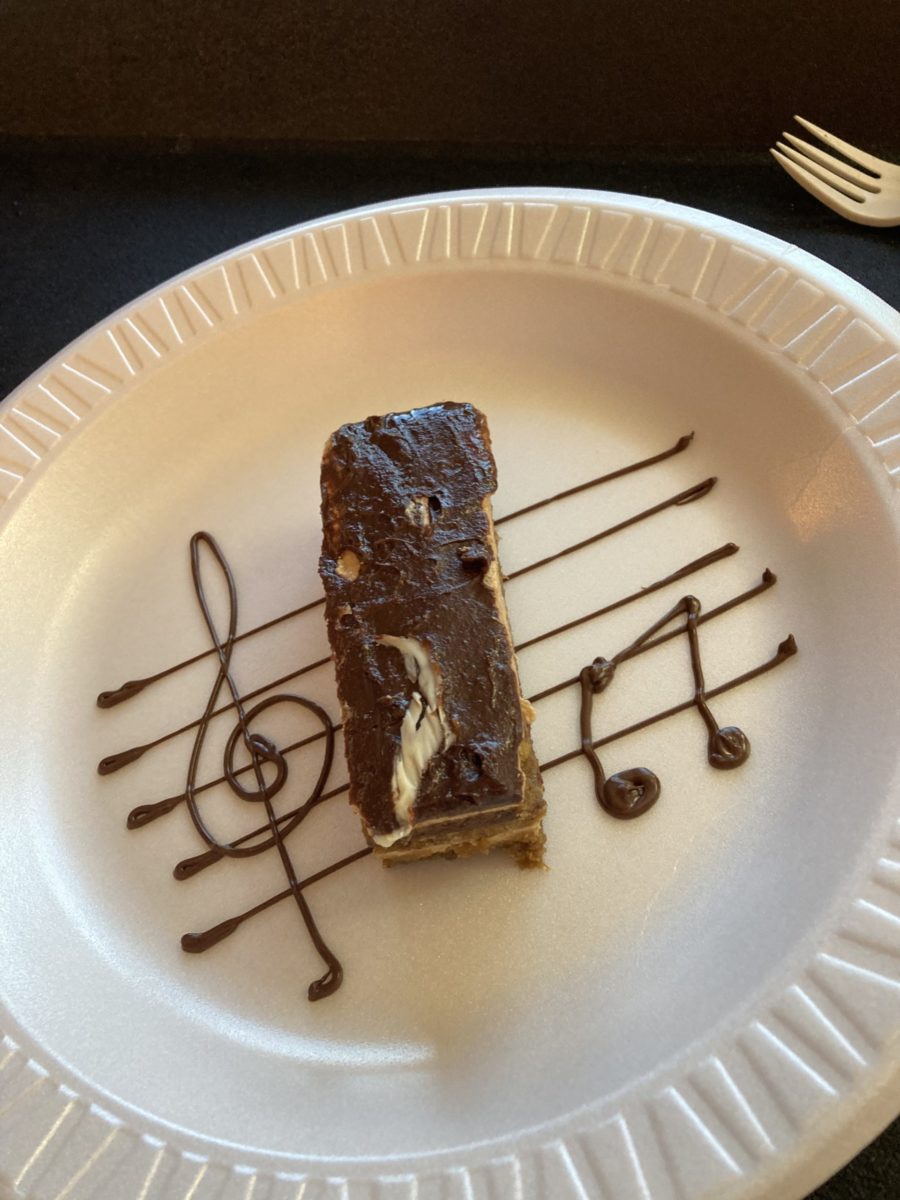
When we were in quarantine, the maitre d’ always called and read the menu so we could decide what to have brought to our cabin. One of Laurel’s choices was this delicious chocolate eclair. * Photo: Laurel Zimmermann
Free to Go Exploring Again
After two days and a second negative test I was allowed to emerge, masked, so in Sault Ste. Marie I could visit the bulk carrier Valley Camp, right next to our dock and a stop on the hop-on, hop-off.
This museum ship had an exhibit on the doomed ore-carrier Edmund Fitzgerald that included one of its lifeboats. (In Detroit I’d walked by the Mariners Church, where, according to Gordon Lightfoot’s stirring ballad, the “church bell chimed ‘til it rang 29 times/ for each man on the Edmund Fitzgerald.”)

The Edmund Fitzgerald exhibit aboard the museum ship Valley Camp. * Photo: Karl Zimmermann

The Mariners Church in Detroit, made famous in Gordon Lightfoot’s song. * Photo: Karl Zimmermann
“Sea Time” & Locks on the Great Lakes
I knew my best moments would be on deck, and I was happy to be back out there at least sporadically after quarantine.
When I’d seen the detailed itinerary, I’d been a bit disappointed that port arrivals seemed early and departures late, since the maritime aspects of the Great Lakes were a major attraction for me.
As it turned out, Captain Violkowski proved sensitive to this, arranging to push our scheduled 7 p.m. departure from Toronto up 35 minutes so we would reach Lock 1 of the Welland Canal in daylight—which we did, at 8:45 p.m.
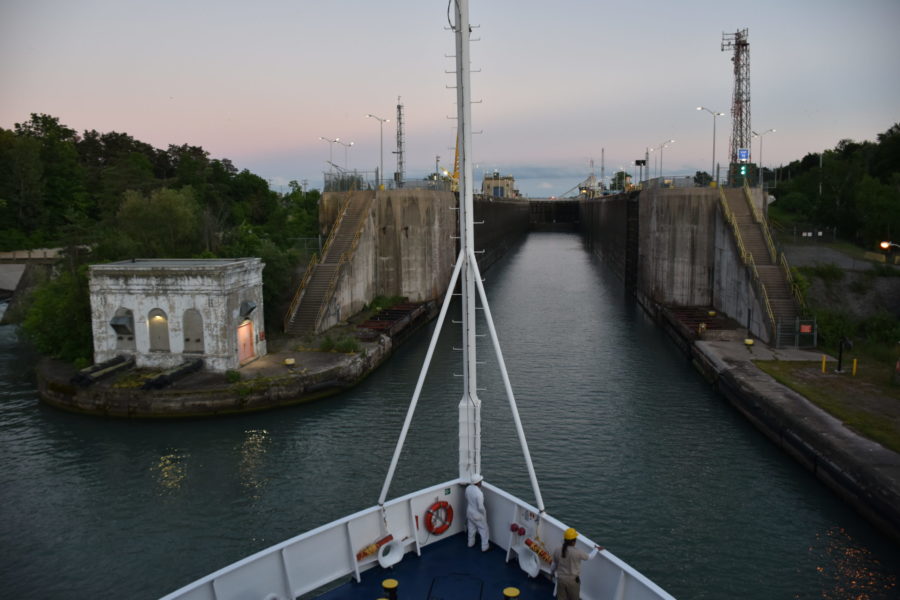
The light is fading as we enter the Welland Canal. * Photo: Karl Zimmermann
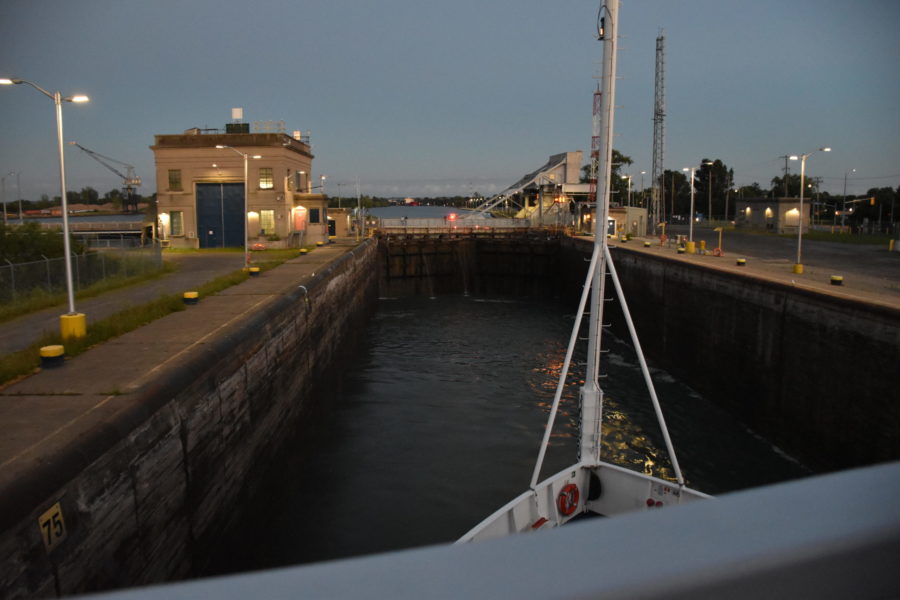
We’re in the lock and it’s begun to fill. * Photo: Karl Zimmermann
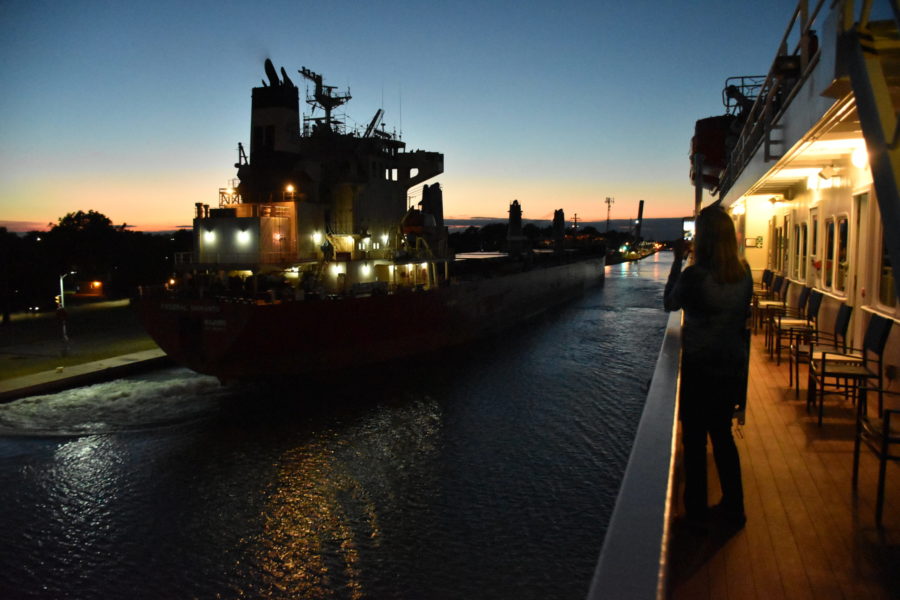
We’ve locked through and our friend Momo, as much a presence on deck as we, captures the Federal Champlain, home-ported in Maduro, about to enter the lock. * Photo: Karl Zimmermann
Locking through was a beautiful crepuscular experience, ending with the western sky streaked with orange.
Then, two days later our Captain responded to requests of previous passengers and moved Cleveland sailing from 9 p.m. to 6 p.m. for better views of the city skyline.
Entering, we’d gotten a glimpse of our first classic “laker,” the elegantly painted Wilfred Sykes, which began service in 1950 as a “straight decker,” as all bulk carriers were then.
What’s distinctive about the look of a lake boat is the separation of the “forward house” — the domain of the deck officers — and the smokestack-capped “aft cabin,“ where meals are prepared and served to both officers and crew, where and the engineers live and work. Between the two are the hatches, topped these days by an ungainly “self unloading” crane.
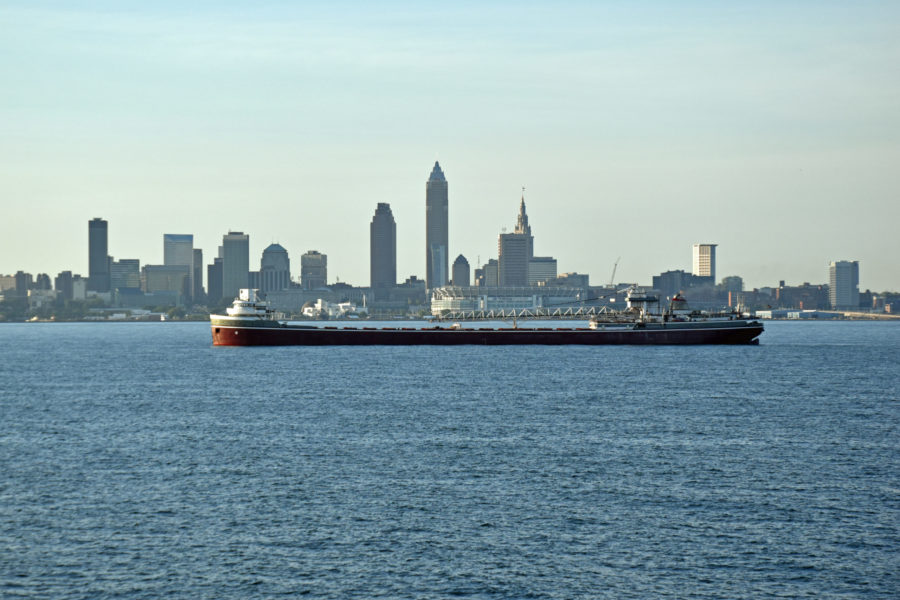
The beautifully tricked-out veteran Wilfred Sykes with the Cleveland skyline in the background. * Photo: Karl Zimmermann
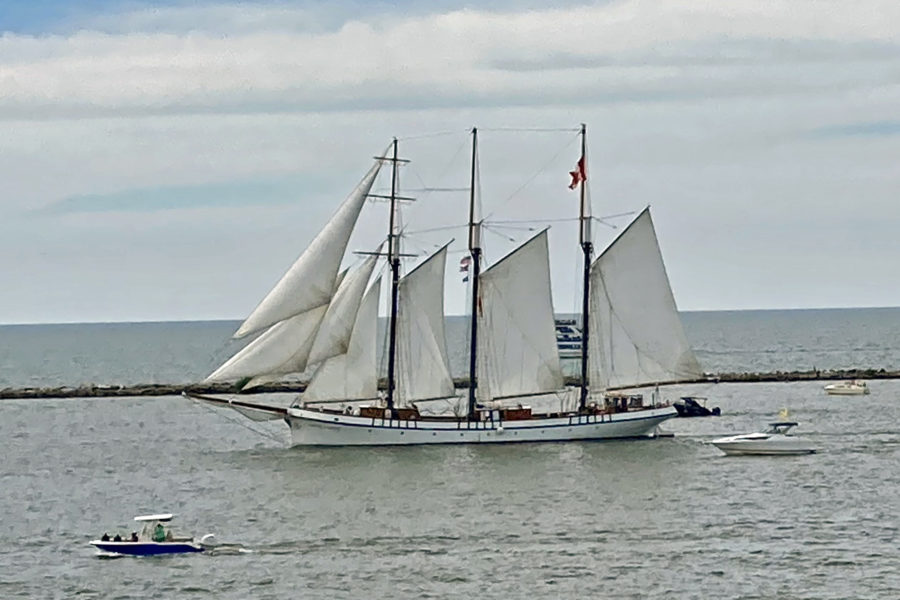
By chance, we caught a tall ships parade when we were in Cleveland. * Photo: Laurel Zimmermann.
Passage Through the Soo Locks
The greatest gift to boat buffs aboard (in Great Lakes vernacular vessels are “boats,” even the famous Edmund Fitzgerald and its 1,000-foot-long successors, unless they’re “salties,” coming in from the Atlantic) was passage through the Soo Locks.
Earlier in the day, the Sault Ste. Marie hop-on, hop-off tour had included the locks and a chance to watch the maritime traffic from the viewing stands.
But in the afternoon the Ocean Voyager would transit the Soo locks into Whitefish Bay, our taste of Lake Superior, so we’d have all five lakes.
Then we’d head back and be on our way to Mackinac Island, the next day’s port.
I bet this double transit was an expensive present to us.
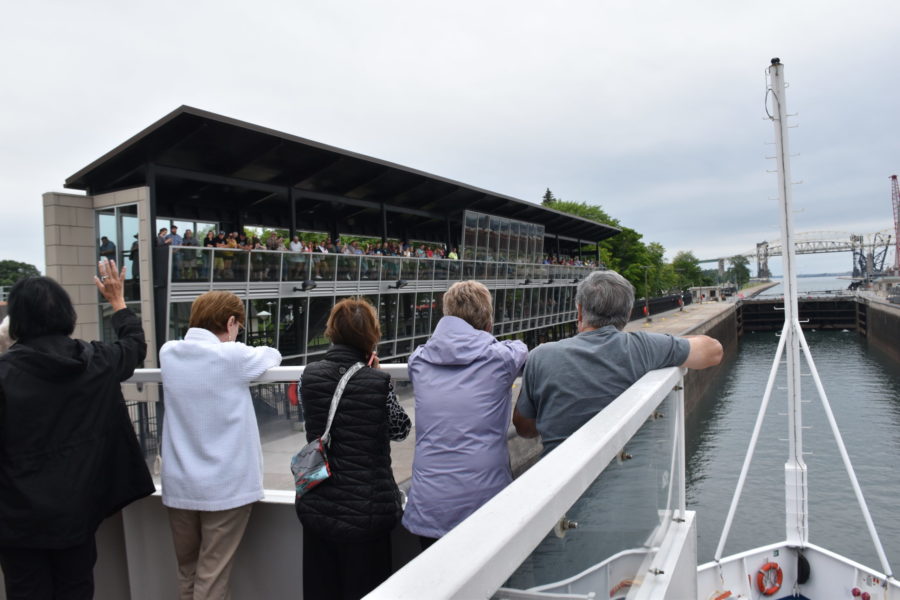
Entering the lock at the Soo, we saw the visitors’ gallery on the port side, where we might have perched on tour in the morning. * Photo: Karl Zimmermann
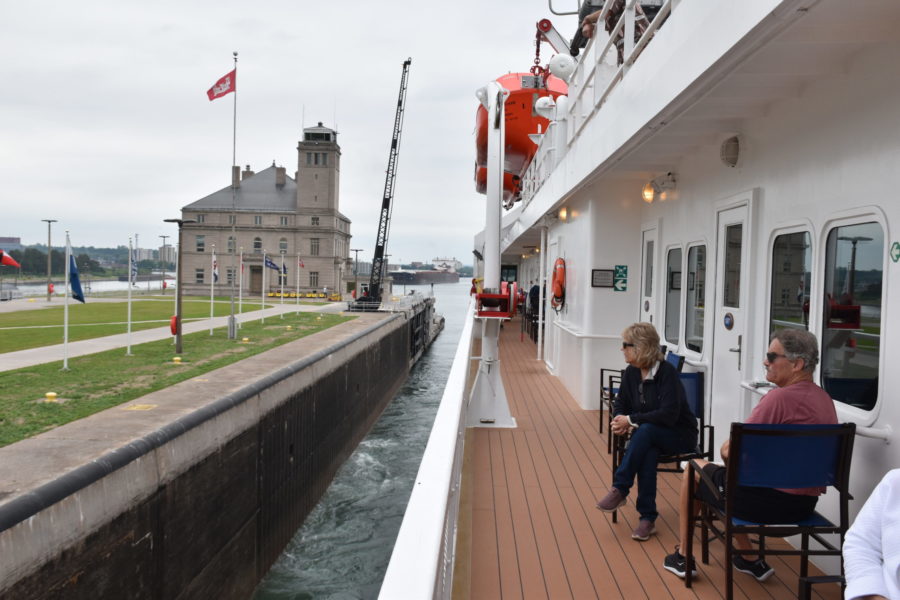
The architecture at the Soo Locks is classic stone. * Photo: Karl Zimmermann

Momo and Eddy are on the Sun Deck as Algoma Central’s Radcliffe R. Latimer is down-bound in the adjacent lock. * Photo: Karl Zimmermann
Outdoors Was Not Everybody’s Cup of Tea
Though the decks were crowded for the Soo transit and our entrance into the Welland Canal, only a handful of passengers were on deck for other serendipitous moments I found special.
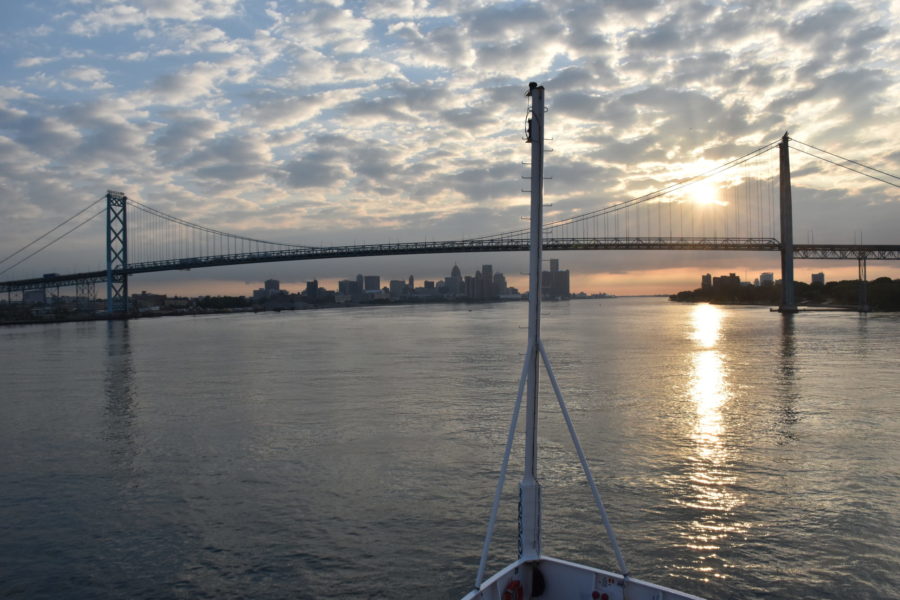
I didn’t have much company on deck as we approached the Ambassador Bridge in early morning sailing up the Detroit River. * Photo: Karl Zimmermann
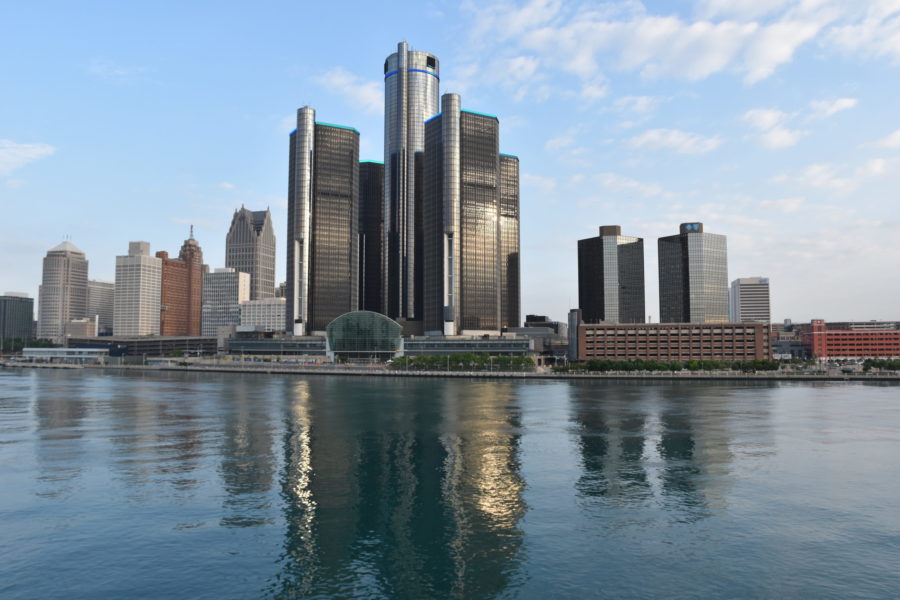
The Renaissance Center shines in morning light as we dock in Detroit. * Photo: Karl Zimmermann
Hanging out forward on the Terrace in Detroit waiting for our afternoon tour, I spotted up-bound (away from the Atlantic) the Kaye E. Barker passing under the Ambassador Bridge linking Windsor, Ont., and Detroit.
Built in 1952, this Interlake Steamship Co. vessel is one of the oldest and most traditional in service.
At the same time I noticed a small boat approaching us; it turned out to be the unique J. W. Westcott II.
The function of this floating United States Post Office (which has its own zip code) is to service lakers and salties transiting the Detroit River, perhaps many days from any port. It had packages for us.

The Kaye E. Barker and J. W. Westcott II are headed our way. * Photo: Karl Zimmermann
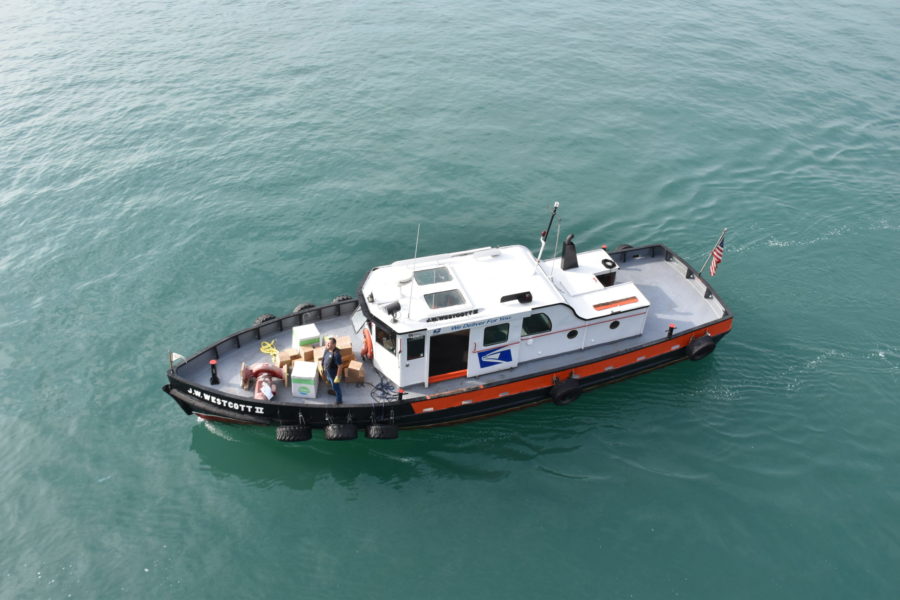
The Westcott II shows its logo as a full-fledged Post Office. * Photo: Karl Zimmermann
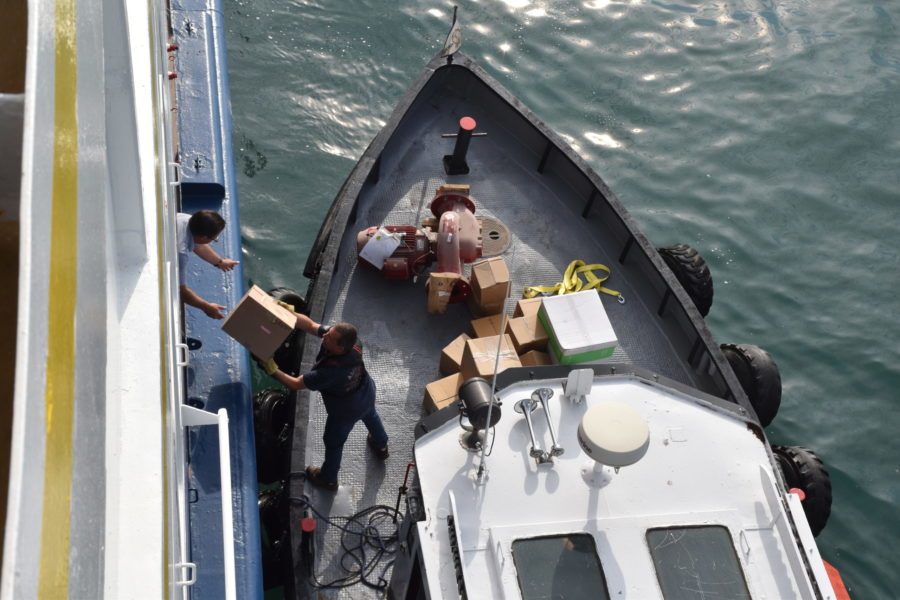
The Westcott II delivers packages to Ocean Voyager. * Photo: Karl Zimmermann
Mackinac Island & Beyond
Mackinac Island, the final port, can be seen as a classic tourist destination, with throngs of day-trippers pouring off the ferries from Mackinaw City and filling the shop-lined Main Street sidewalks.
On the other hand, its eschewing internal combustion gives the island a timeless quality.
Like most tourists I was entranced by the carriages (the Grand Hotel’s was the most elegant), but equally by the drays delivering everything that was needed to serve us tourists.
The aged-corrugated metal and wood Star Line transfer sheds where we docked spoke of another time.
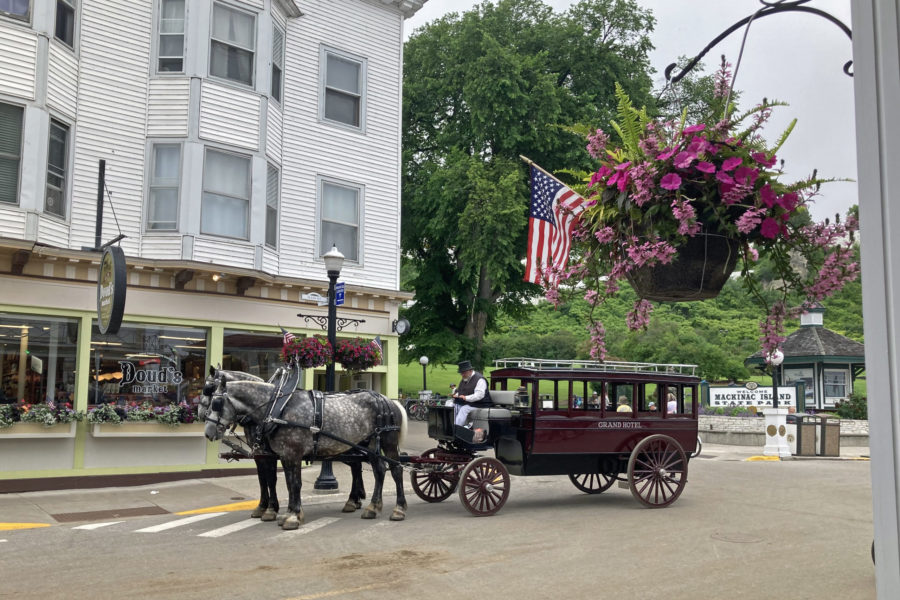
The Grand Hotel carriage. * Photo: Karl Zimmermann

On Mackinac Island, everything moves by horse. * Photo: Karl Zimmermann

Horses and the Star Line transfer sheds spoke of another era. * Photo: Karl Zimmermann
I skipped the included carriage tour (as well as the “Premier” buffet lunch at the Grand Hotel, which included salads, seafoods, cheeses, a carvery, and fresh baked desserts) and just walked to the magnificent hotel, still radiating all its 1887 glory. I sat on its porch, claimed to be the longest in the world, and I can believe it.
Since the hotel was a stop on the carriage tour, I showed my cabin key and toured the lobby and other public rooms.
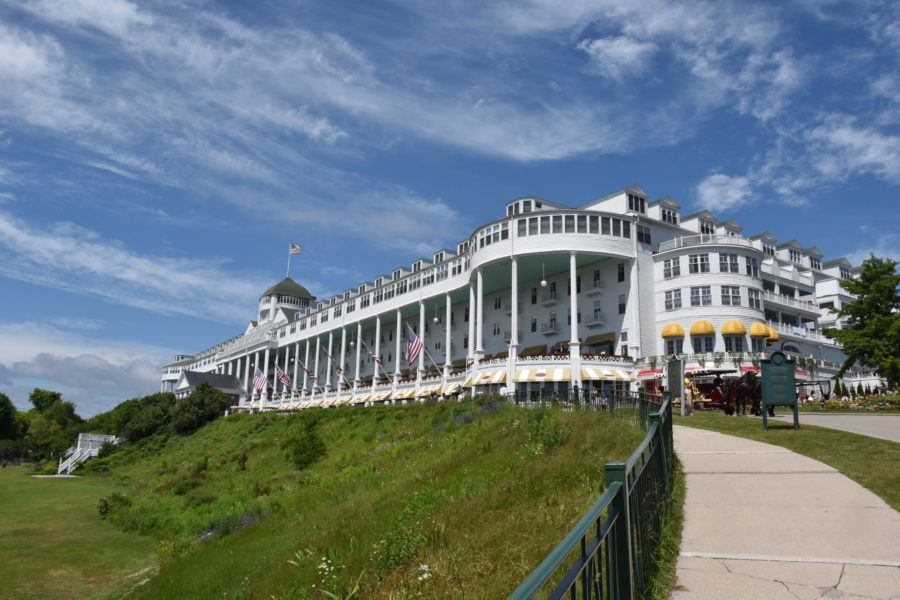
The Grand Hotel. * Photo: Karl Zimmermann
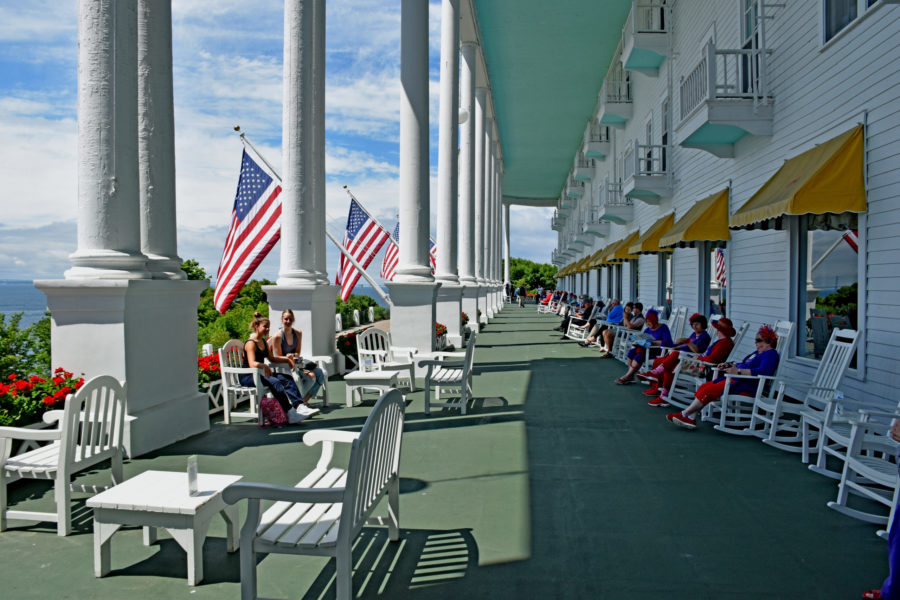
The wonderful porch had room for all of us. * Photo: Karl Zimmermann
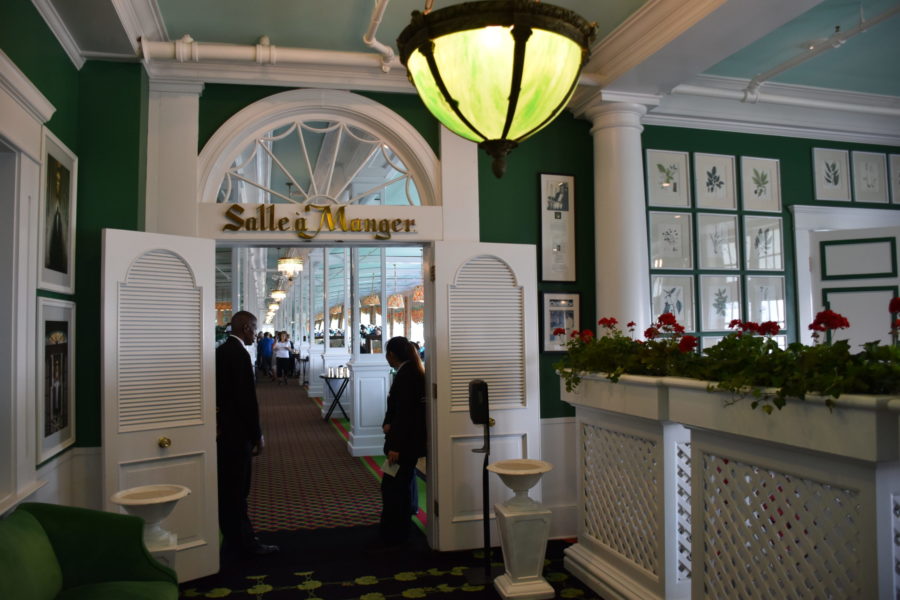
The Grand Hotel’s dining room where the luncheon buffet was held. * Photo: Karl Zimmermann
Moving on Again
We loosed lines at dusk and headed south on Lake Michigan via the Straits of Mackinac.
Spanning the straits and catching the afterglow was the Mackinac Bridge, built in 1957 to link Michigan’s Lower and Upper Peninsulas.
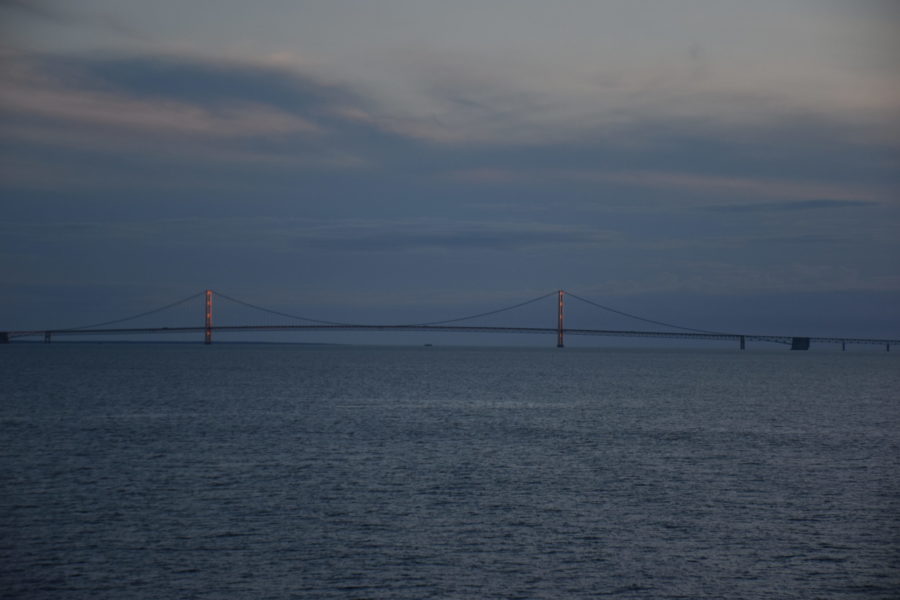
The Mackinac Bridge in its expansive elegance. * Photo: Karl Zimmermann
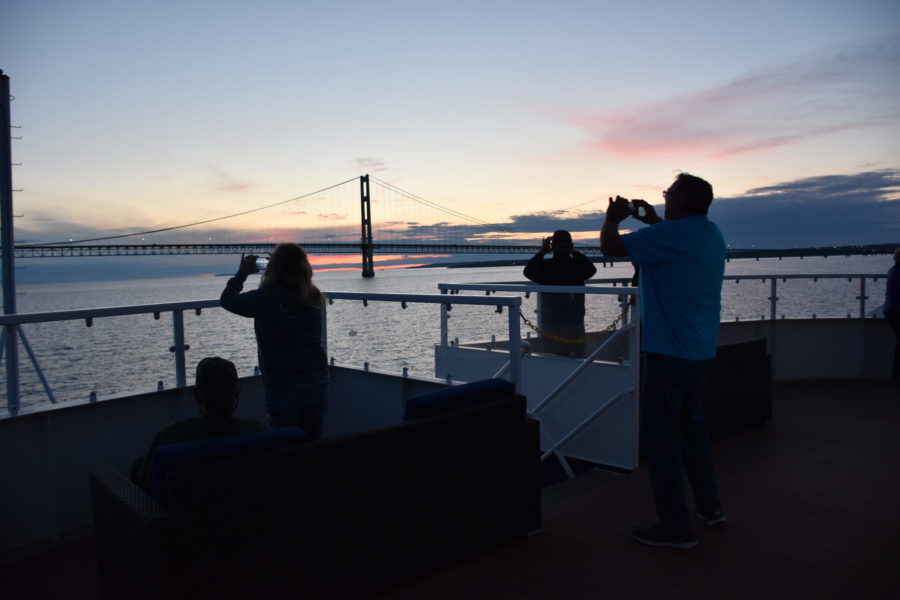
Sunset brought more passengers on deck as we neared the bridge. * Photo: Karl Zimmermann
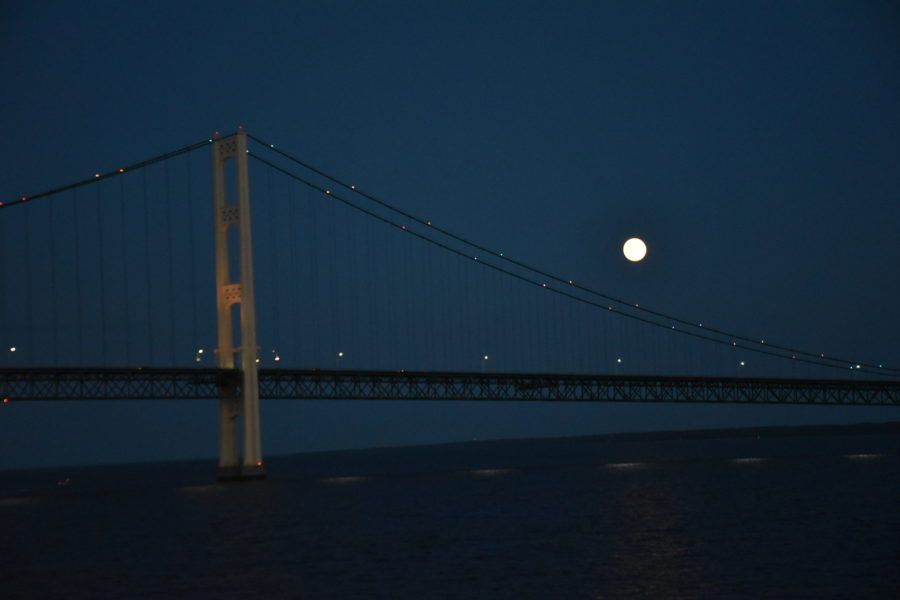
The Super Moon rises. * Photo: Karl Zimmermann
After we passed under the bridge the dozen or so of us on deck watched a “Super Moon” (which occurs when a full moon’s orbit comes closest to the Earth) rise behind it.
At least the moon was visible from our portside cabin so incarcerated Laurel caught a glimpse (ironically she wouldn’t test negative until the morning we disembarked in Chicago).

Chicago Moonset. * Photo: Karl Zimmermann
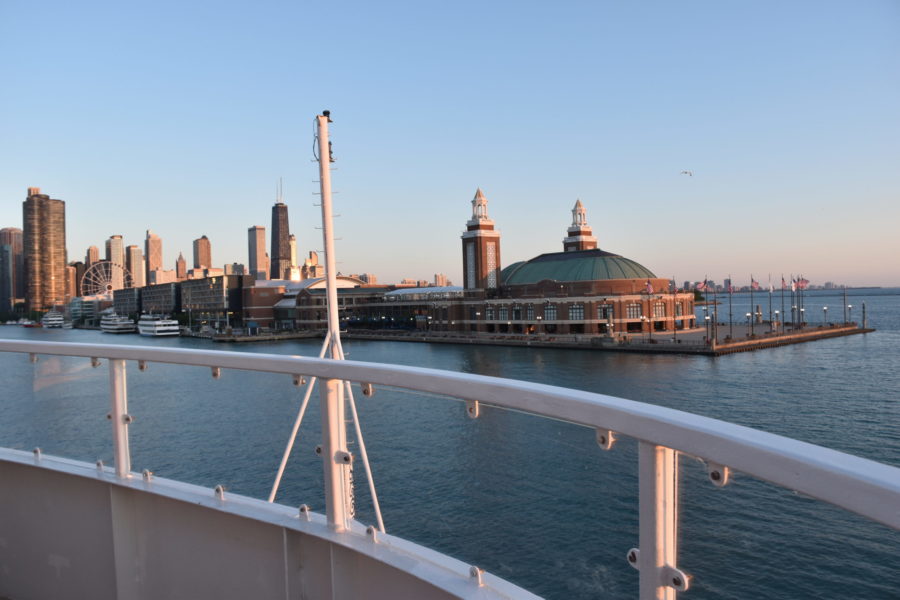
Docking at the Navy Pier in Chicago brought our voyage to an end. * Photo: Karl Zimmermann
Bittersweet, as our Great Lakes Cruise Comes to an End
That moon hovered over the Chicago skyline when we arrived the morning after our Lake Michigan transit.
Chicago, often called “the Second City,” is second in my heart only to New York. And we’d have loved to tour its magnificent architecture, sail on the Chicago River, and dine at our favorite restaurants, but this time getting home was the imperative.
Hard for me not to have good feelings about the Ocean Voyager, in spite of what we (especially Laurel) missed.
It was a particular pleasure to see places from the water that we’d seen from land, a most enjoyable new perspective.
Maybe we’ll need to go again another year.
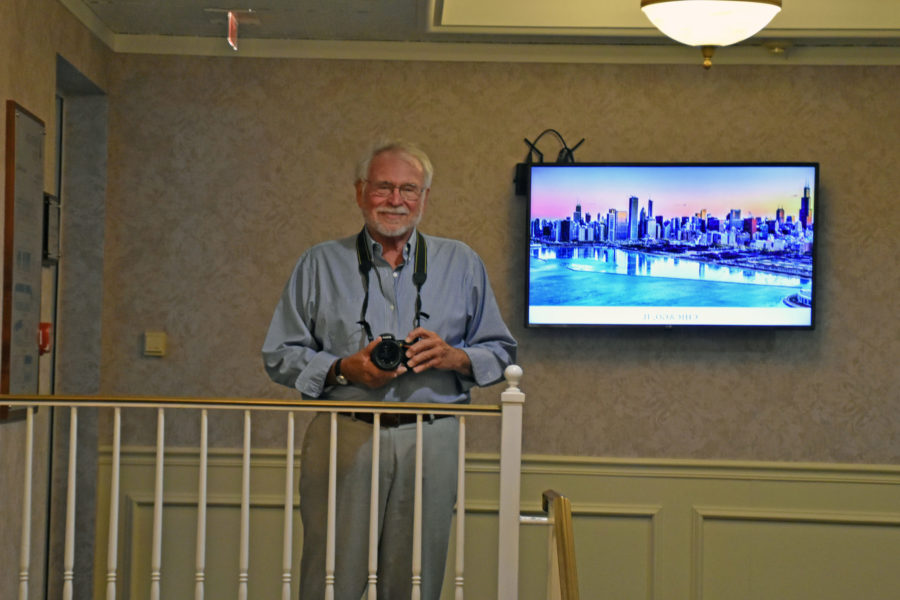
The author Karl Zimmermann in a mirror-assisted self portrait.
Interested in this Great Lakes Cruise?
Fares for the 10-night package (nine on the Ocean Voyager plus one pre-cruise hotel night) are listed on the American Queen Voyages website starting at $4,999 per person, including daily excursions, open-bar and transfers.
However, keep your eyes open for special offers from American Queen Voyages, such as discounted fares and free airfare.
RELATED: The 2023 Great Lakes Cruise Season — We Share Who’s Going!
RELATED: Karl Zimmermann shares his photos & experience of the Trinity House Patricia ship.
Don’t miss a post about small-ship cruising, subscribe to QuirkyCruise.com for monthly updates & special offers!
© This article is protected by copyright, no part may be reproduced by any process without written permission from the author. All Rights Reserved. QuirkyCruise.com.


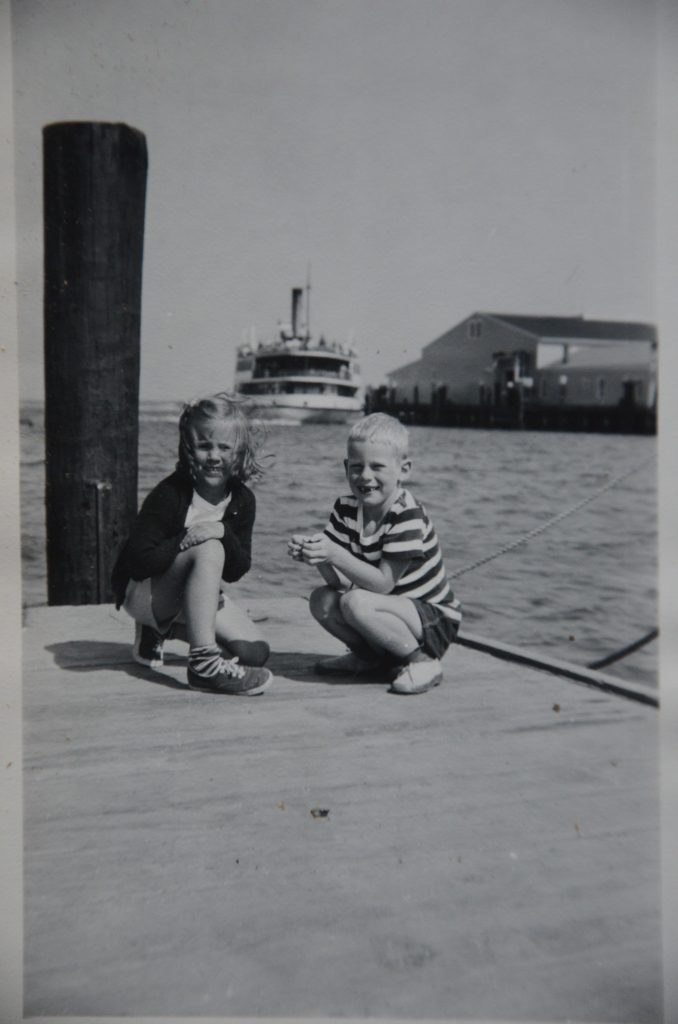
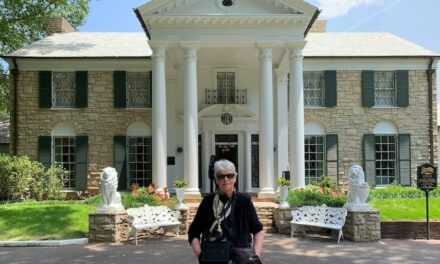
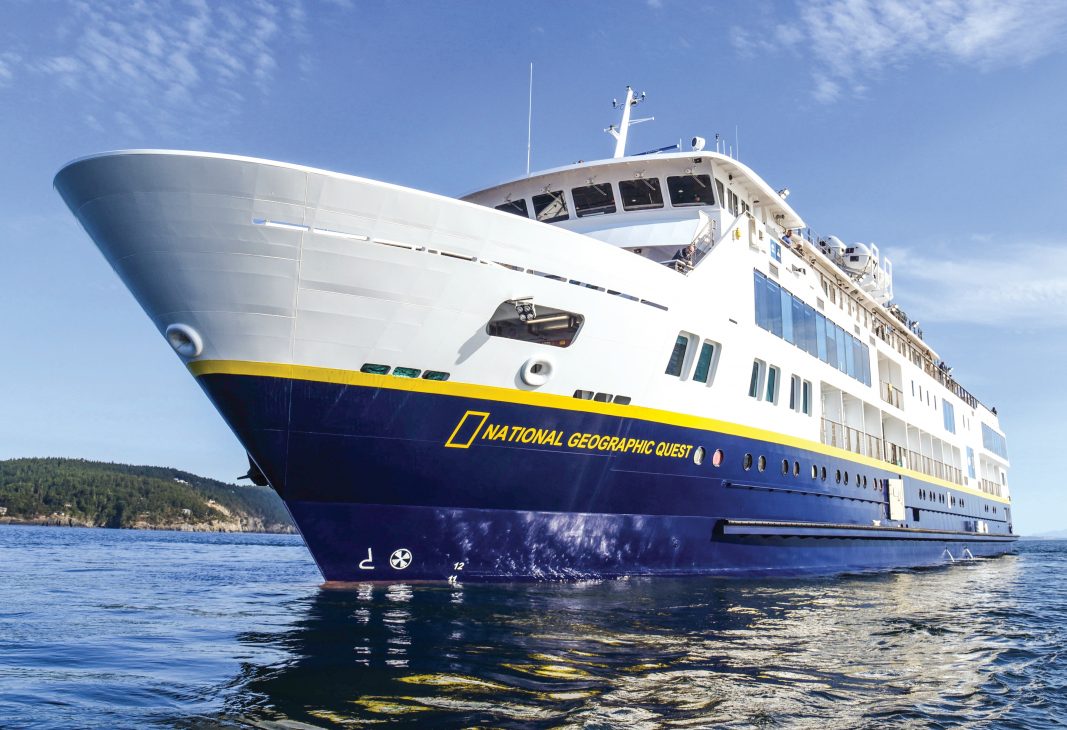
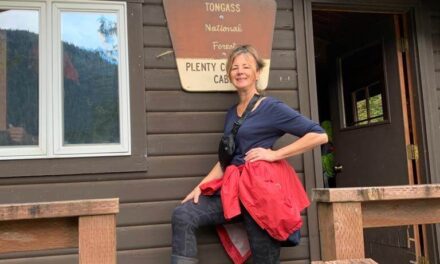
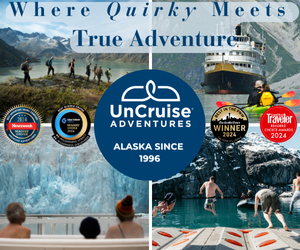


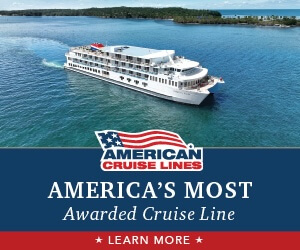




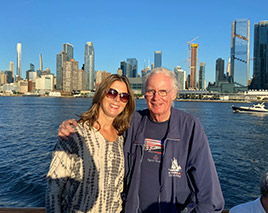 HEIDI SARNA
HEIDI SARNA
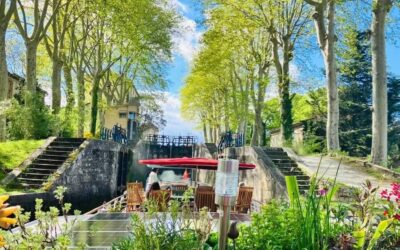


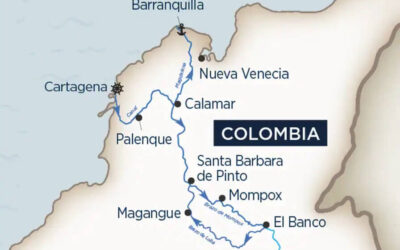
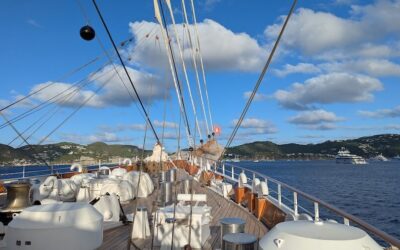
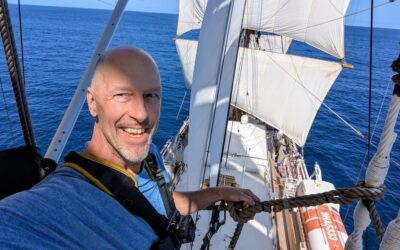
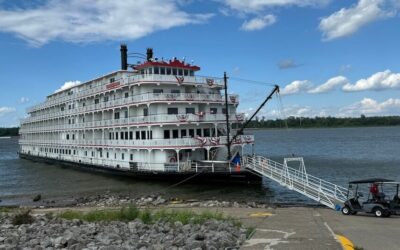
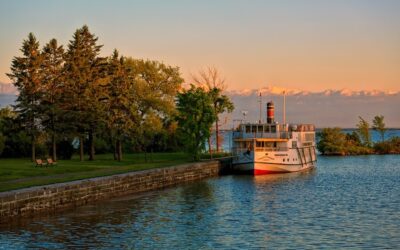

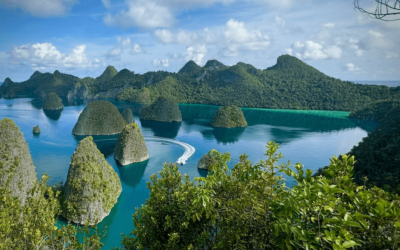


Wonderful report from Karl Zimmermann, whose knowledge and love of ships shines through and adds so much insight! Thanks for a frank, colorful and informative story and the map and great photos. Sparkling writing — I laughed at the “martini as god intended.” What a drag, though, that Laurel had to miss many of the highlights. Hopefully that yummy-looking chocolate eclair gave some comfort to the cabin-bound.
I was fortunate to be seated at a dining table with Karl and Laurel aboard Deilmann’s Deutschland years ago on a cruise through the Mediterranean and Suez Canal to Egypt and Jordan, and their company really added to the fun and adventure. I well remember Karl on deck with his binoculars, and trekking with Laurel to Cairo and the pyramids at Giza.
We also all enjoyed Deilmann’s sekt!
Thanks, Anne, for the lovely comments. Coming from you it’s especially meaningful and appreciated. We too enjoyed our being together on that wonderful Deutschland voyage, the best of company on top of all the other good things about that trip.